同等学力申硕10年真题考试已考会话技能中的习惯用法 (独家整理)
同等学力学位英语历年真题高频词汇(最新整理9页)
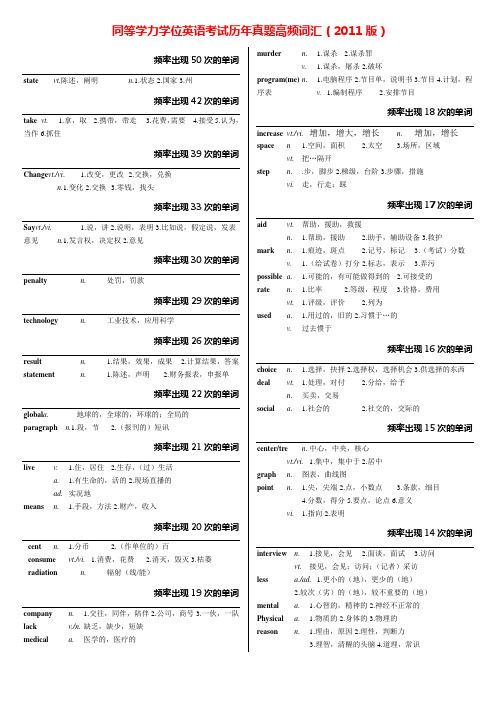
ad.最后(地),上一次,最近一次vi.持续,维持matter n. 1.事情,问题 2.毛病,麻烦,困难3.物质,物品million num.百万,百万个n.(pl.)无数pollution n.污染public a. 1.公共的 2.公众的 3.公开的n.民众,公众revenge vt./n.报复,复仇rise vi. 1.上升,上涨 2.升起3.站起,起床4.增强5.起义n. 1.增加,升高 2.加薪 3.高地,高坡society n. 1.社会 2.协会,团体spend vt. 1.花费(钱、时间、心血等) 2.消磨,度过vi. 1.花费,浪费 2.耗尽stock n. 1.储备,贮存 2.存货,现货3.股票4.家畜,牲畜vt.储备,备货title n. 1.标题 2.头衔,称号volunteer n.自(志)愿者频率出现11次的单词culture n. 1.教养,修养 2.文化,文明emission n. 1.发射,散发 2.发出物,发射物function n. 1.功能,作用 2.职务,职责 3.〈数学〉函数vi. 1.(器官等)活动,(机器等)运行 2.行使职责importance n. 重要,重要性individual a. 1.单独的,个人的 2.独特的,个性的n.个人,个体;独立单位late a. 1.迟的,晚的 2.晚期的,末期的3.最近的,已故的ad.迟,晚level n. 1.水平面,水平线 2.等线,水平a.平的,水平的limit vt.限制,限定n.界限,限定,限度material n. 1.物质,材料,原料 2.素材,资料,题材a.物质的minute n. 1.分,分钟 2.一会儿,片刻3.(pl.)会议记录necessary a. 1.必要的,必需的 2.必然的n.(pl.)必需品nuclear a. 1.原子核的 2.核心的,中心的patient n.病人a.有耐心的,能忍耐的research vi./n研究,探讨travel vi. 1.旅行 2.行进,走 3.运行,传播n.旅行type n. 1.类型,式样2.印刷字体3.活字,铅字v.打字频率出现10次的单词applicant n.申请者cell n. 1.细胞 2.电池 3.单人牢房4.小房间common a. 1.普通的,寻常的 2.共有的,公共的crime n.罪,犯罪factor n. 1.因素,要素 2.〈数学〉因数,因子harmful a.有害的international a.国际的,世界性的least a.最小的,最少的ad.最少,最小,最不n.最小,最少line n. 1.线,(文章的)行2.电线,线路3.路线,航线vt.(使)排成行main a.主要的,最重要的n.(输送水或煤气的)总管道,干线manner n 1.方式,方法2.态度,举止3.(pl.)礼貌,规矩personal a. 1.个人的,私人的2.本人的3.身体的,容貌的pressure n. 1.压力,压强 2.强制,压迫prevent v.预防,防止researcher n.研究者,调查员scientific a.科学的serious a. 1.严重的 2.认真的,严肃的sheet n. 1.张,片,页2.被单频率出现9次的单词complete vt.完成,结束a. 1.完整的,全部的2.已完成的,结束的3.彻底的confidence n. 1.信任2.信心,自信,把握current a. 1.通用的2.现时的,当前的n. 1.水流,气流2.电流 3.趋势,倾向drop n. 1.点滴,滴2.下降3.微量vt./vi. 1.滴下2.投下,落下,跌落effort n.努力,尝试environment n.环境,周围状况estimate vt.估计,评价,判断n.估计,估价;(用复数)预算expect vt. 1.期待,预期,盼望 2.认为;料想general a. 1.全体的,普遍的2.综合的,普通的3.通用的n.将军government n. 1.管理,支配 2.政府,内阁investment n.投资,投资额lead n.铅v. 1.领导,引导2.为…带路;指引3.导致;通向n. 领导,领先limited a.小的,有限的remain vi. 1.停留,留下 2.保持,依然save v. 1.拯救 2.储蓄 3.节省sell vt. 1.卖,出售 2.出卖,背叛vi.卖,销售set vt. 1.放置2.使处于某种状态(位置)3.调校4.树立,规定vi. 1.(日、月等)落下 2.凝结,固定3.着手,从事n. (一)套a.固定的,规定的traffic n.交通(量)video n.录像(机)a.录像的,视频的频率出现8次的单词capable a.(指人)有能力的,有本领,能干的certain a. 1.(只作表语)肯定的,无疑的 2.必然的3.(只作定语)某一,某些continue vi.连续,继续decade n.十年effect n.结果,效果,作用vt. 产生,招致,完成fuel n. 燃料,养料vt./vi. 供给燃料,加燃料;刺激;推动imply vt. 意指,含…的意思involve vt. 1.使卷入,使参与 2.包含,包括 3.牵涉likely a.很可能的,有希望的ad. 可能地living a. 活着的,现存的n. 生计,生活measure n. 1.量度,尺寸 2.措施,方法vt. 量,测量vi. 有…长(宽,高)product n. 1.产品,制品 2.结果,成果 3.乘积relate vt. 1.使有联系 2.叙述,讲vi. 与…有关系tend vt 照料,护理vi. 易于,有某种倾向term n. 1.学期2.期限,期间3.术语,措词4.(pl.)条款,条件vt. 称为,叫做频率出现7次的单词available a.可利用的;有效的;可得到的average n. 1.平均(数) 2.一般水平,平均标准a. 1.平均的 2.一般的,通常的avoid vt.避免,回避,逃避behavio(u)r n. 1.行为,表现 2.(机器等的)运转情况care n. 1.牵挂,担心 2.照应,照料 3.烦恼,烦人的事vi. 1.担心,关心,介意 2.喜欢,愿意comprehension n. 1.理解,理解力 2.领悟cross v. 1.穿越 2.相交 3.划横线,勾掉n. 1.十字架,十字形的东西 2.交叉路 3.苦难electronic a.电子(学)的fall vi. 1.落下,降落,跌落 2.陷落,失守 3.降低,减退n. 1.秋季2.落下,降落3.陷落4.下降;减弱keep vt./vi.1.保存,保留2.(使…)保持(着某一状态),使得3.保守,遵守4.保卫,防卫5.赡养,饲养6.看管,经营7.履行,遵循majority n.多数,大多数motorist n.驾车的人,乘车旅行的人murderer n.杀人犯,凶手natural a. 1.自然界的,天然的2.正常的,惯常的3.天赋,天生的occur vi. 1.发生 2.出现,存在popular a. 1.大众喜爱的,喜闻乐见的 2.大众化的,普及的price n. 1.价格 2.代价vt.标价,定价project n. 1.方案,计划 2.工程,项目vt. 1.投掷,发射 2.放映3.设计,规划 4.突出,使凸出pure a. 1.纯粹的 2.纯净纯洁的3.无邪,贞洁的4.完全,彻底的record n. 1.记录,报告 2.经历,履历 3.记录,最好成绩a.创纪录的vt. 1.记录,记载 2.录音,录影,录下refer vi. 1.提到,引用 2.查阅,参考1.vt.叫(人)去…(以便得到消息、援助等)2.把…归因于3.把…委托(交给)…regard vt. 1.把…看作,把…认为 2.注意,注视3.对待,看待4.尊重,尊敬n. 1.注意,注视 2.尊敬,尊重 3.(pl.)问候,致意retail n. 零售v.零售ad.以零售价格seal n. 1.封条 2.印章vt. 1.密封 2.盖章section n. 1.节,段,部分 2.科室 3.截面,剖视图single a. 1.单个的,单一的 2.独身的 3.每个的,个别的vt.挑选species n.物种,种类suggest vt. 1.建议,提议 2.表明,暗示trend n.趋势,倾向vi.趋向,倾向typical a. 1.典型的,有代表性的 2.特有的,独特的victim n.受害者,牺牲者,遇难者频率出现6次的单词acquisition n获得(物)adapt vt 1.使适应,使适合 2.改编,改写allow vt 1.允许,准许 2.承认 3.给予vi(~for)考虑到,顾及apply vi./vt. 1.请求,申请 2.适用,应用,运用3.把…应用于approach vi./vt. 1.走近,接近,临近 2.处理,对待n. 1.走近,接近 2.(处理的)方法 3.看法,观点astronaut n. 宇航员attack vt./n.1.攻击,袭击 2.(疾病)发作attitude n. (与介词to,towards连用)态度,看法balance n. 1.平衡,均衡 2.收支平衡,收付余款3.秤,天平vt./vi. 1.(用天平)秤 2.使平衡 3.(收支)相抵clear a. 1.光亮的,清澈的 2.清晰的,条理清楚的3.晴(天)的vt. 打扫;使清楚,晴朗起来;清除,收走complex a. 复杂的;综合的concept n. 概念,观念;思想control n./vt.1.管理,控制,支配 2.(感情等的)抑制,节制corporation n. (大)公司damage n. 1.损害,毁坏 2.(用复数)损害赔偿金vt. 损害,损伤;毁坏data n. 资料,数据decline vt./vi. 1.拒绝,婉谢 2.下降;(太阳)落山;衰弱n. 1.衰弱 2.斜坡emergency n. 突发事件,紧急关头,非常时刻endanger vt. 危害,危及extinct a. 1.熄灭的 2.灭绝的,绝种的jam vt./vi.1.压紧;(被)夹住2.突然用力推n. 1.果酱2.阻塞,轧住leave vt. 1.离开 2.留下,剩下,使处于(某种状态)3.遗留,遗忘4.听任,让5.交托,委托vi. 离开,出发n. 1.许可,准许 2.准假;假期lie vi. 1.躺,平放 2.位于,在于3.撒谎,说谎n 谎话,假话loss n. 1.遗失,丧失2.亏损,减少,损失3.失败,输掉nature n. 1.自然界,大自然 2.性质,本性object n. 1.物,物体 2.目的,目标 3.对象v. 不赞成,反对perception n. 1.知觉,知觉力 2.理解,认识progress n 1.前进,进展 2.进步,发展vi. 1.前进,进展 2.进步,发展prove v. 1.证明,证实 2.证明是,表明是reflect vt. 1.反射 2.反映,表达vi. 1.反射,映出 2.仔细考虑,思考replace vt. 1.把…放回原处 2.取代 3.替换,更换response n. 1.回答,回应 2.反应,反响restrict vt. 限制,约束riot n. 骚乱,暴动vi. 闹事,骚乱safety n. 安全service n. 1.服务 2.公共事业 3.服役vt. 维护,保养shift v. 1.变换,转换 2.变(速),调(档)n. 1.转变,更换 2.轮班,换班significance n. 1.意义2.重要性smoke n. 1.烟,烟雾 2.吸烟vt. 1.吸(烟) 2.烟熏vi. 1.吸烟 2.冒烟solve vt. 解决,解答surrounding n. (pl.)环境,周围的事物a. 周围的theory n. 1.理论,原理 2.意见thought n. 1.想法,看法 2.思想,思维 3.打算,意图total a. 总的,全部的n. 总数,总计vt. 计算…的总和vi. 总计,合计tradition n. 1.传统 2.惯例,规矩university n. (综合性)大学value n 1.重要性,用途,用处 2.价值3.评价vt. 1.给…估价 2.看重,珍视view n. 1.风景,景色 2.看法,见解 3.视野,眼界vt. 1.把…看成是,认为 2.观察,检查频率出现5次的单词adequate a.足够的,充分的appear vi. 1.出现,露出 2.似乎,好像atmosphere n. 1.大气层 2.气氛,环境aware a.(用作表语,与介词of连用)意识到的,觉察到的belong vi. 1.属于 2.应归入(类别、派别、范畴等)bother vi./t.1.打扰,麻烦 2.费心,烦心n. 1.麻烦,困扰 2.麻烦的人或事物creature n.人,动物,生物cue n.暗示,提示custom n. 1.习惯,习俗 2.海关;(用复数)关税dependent a. 1.依靠的,依赖的 2.从属的diagnosis n. 1.诊断 2.调查分析electrical a.与电有关的,电气科学的;用电的entire a.全部的,整个的exchange vt. 1.交换,调换 2.交流,互换n.交换,调换failure n. 1.失败,不及格 2.失败的人(或事)3.故障,失灵4.没做到,不履行feedback n.反馈former a.以前的,在前的heap n. 1.堆 2.大量,许多vt.使成堆,堆积,堆起image n. 1.像,形象 2.影像,图像immediate a. 1.立即的,即刻的 2.直接的,最接近的impact n. 1.碰撞,冲击力 2.效果,影响improve vt./vi. 1.改善,改进,增进 2.好转,进步insight n.洞悉,洞察力,见识,深刻的了解Issue vi./vt. 1.流出,放出 2.发行,出版,颁布n. 1.发行(物),(报刊)期号2.问题,争论点,争端lot n. 1.许多,大量 2.签,抽签lower a.较低的,下等的,下游的vt.放下,放低,降低marry vt.同…结婚mention v.提到,谈到n.提述,提及national n.国民(指侨居国外的)a. 1.全国性的 2.国内的,本国的3.民族的4.国有的network n. 1.网状织物 2.网状系统 3.广播(电视)网objective a.客观的n.目标,目的organize/-ise vt. 1.组织,安排 2.筹办practical a.实际的,实用的prefer v.更喜欢,宁愿previous a.先的,前的,以前的raise vt. 1.抬起,举起 2.提出,发起 3.抚养,饲养 4.募集,筹集n.加薪reduce vt. 1.减少,减低 2.使…变低3.贬低,使沦落4.(数学)约简vi. 1.减小,减少 2.减肥relation n. 1.家人,亲戚 2.关系 3.叙述,陈述relationship n. 1.关系 2.亲属关系rescue vt./n.救援safe a.安全的n.保险箱self n. 1.自己,本身 2.私心sense n. 1.意思,意味 2.感觉,感知3.见识,判断能力4.意识,理智vt.觉得,意识到share vt. 分享,分给,分担n. 1.部分,一份 2.股份,股 3.分担,均摊sign n. 1.符号,记号 2.姿势,手势3.标识,牌示4.征兆,迹象v. 1.签名 2.作手势(表示)similar a. 相似的,类似的situation n. 1.形势,情况 2.处境,境况 3.位置,场所status n. 1.地位,身份 2.情形,状况,状态store n. 1.商店,店铺 2.贮备品vt.贮藏,贮备suffer vt. 1.忍受,承受 2.遭受vi. 1.忍受痛苦 2.受损失survival n. 1.幸存(者) 2.遗物threat n. 1.威胁,恐吓 2.凶兆,征兆transmit vt.传播,播送;传递,传导,传送tribe n.部落,宗族various a. 1.不同的,各种各样的 2.多方面的vast a. 1.巨大的,广大的 2.大量的 3.非常的wave n. 1.波,波浪 2.(手等的)挥动vt.挥动,向…挥手vi. 1.挥手示意 2.波动,飘动zone n. 地区,地带,区域频率出现4次的单词account n. 1.账目,(复数)账户2.说明,陈述 3.原因,理由vi.说明(理由等)agreement n. 1.同意,达成协议 2.协定,协议amount vi. 1.总计 2.(与介词to连用)等于n.总额;数量appliance n. 1.器械,装置 2.应用,适用arrow n. 1.箭(状物) 2.箭头符号aspect n. 1.(问题,事物等的)方面 2.样子,面貌bamboo n.竹,竹类block n. 1.大块(木料或石料,金属等) 2.障碍物,阻塞物3.街区(四条街道当中的地区)vt.阻拦,堵塞broadcast vt./vi. 〈无线电〉广播(节目)n.无线电广播,播音career n. 1.职业 2.生涯cast vt. 1.投,抛 2.撒(网) 3.铸造,浇铸n.一掷;撒网;铸件cause n. 1.原因 2.理由,缘故 3.事业,奋斗目标vt. 1.造成,引起 2.使得chase vt.追赶,追逐n.追赶,追击choose vt. 1.挑选,选择 2.愿意,决定consider vt. 1.考虑,细想2.体谅,顾及3.认为,以为,把…看作vi.考虑convention n. 1.习俗,惯例 2.(社团,政党等)大会,会议3.公约,契约cope vi. 1.(善于)应付,妥善处理 2.竞争detail n. 1.细节,详情 2.枝节,琐事vt.详述,详谈enormous a.巨大的,庞大的entertain vt. 1.使欢乐,使娱乐 2.招待,款待 3.持有(意见、见解等)evidence n. 1.根据,证据 2.形迹,迹象executive a.实施的,执行的,行政的n. 1.总经理,董事 2.执行者3.行政部门exist vi. 1.存在 2.生存,生活express vt.表示,表达n.快车;快递,快汇extreme a. 1.极度的,极端的 2.尽头的,末端的n.极端,最大程度;在末端的事物flight n. 1.飞行,飞翔 2.航空旅行,航程 3.航班focus n.焦点,(活动、兴趣等的)中心vi./vt.使聚焦,集中fossil n.化石fundamental a.基本的,根本的,主要的;原始的n.(常用复数)基本原理,基本原则historical a.历史的,有关历史的ideal a. 1.理想的,完美的 2.观念的n. 理想impression n. 1.印,印痕 2.印象,感想 3.印记intend vt.想要,打算,企图locate vt. 1.把…设置在,使…坐落于 2.探明,找到logical a.逻辑的,合乎逻辑的lost a. 1.失去的 2.错过的,浪费掉的 3.无望的,迷路的maintain vt. 1.维持,保持 2.保养,维修 3.坚持,主张major a. 1.较重要的,较大的 2.主要的n. 1.主修课程 2.少校vi.(in)主修market n. 1.市场,集市 2.销路,需求vt.销售mid adj.中央的,中间的mystery n. 1.神秘,奥秘 2.神秘的事物notion n. 1.概念,意念 2.想法,见解opinion n. 1.意见,看法 2.舆论,评价organization n. 1.组织,安排 2.团体 3.有机体overseas ad./a.到国外(的),到海外(去的)ownership n.所有权,所有制participate vi. 1.参与,参加 2.分享,分担predict v.预言,预测,预告protect vt.保护,保卫protection n.保护pump n.泵,抽水机,打气机v.用抽水机抽,打气purchase vt.购买n. 1.购买 2.购买的物品rapid a.迅速的,快速的realize/is Vt. 1.认识到,了解 2.实现receive vt. 1.收到,领到 2.接受,得到3.接待,接见4.遭受,遭到recipe n. 1.食谱 2.方法,窍门register vt. 1.注册,登记 2.(仪表等)显示3.将(邮件)挂号vi.登记,注册n. 1.登记,注册 2.登记簿,花名册regulation n. 1.规定,条例,法令 2.管制,控制 3.调节,调整relief n. 1.(痛苦、烦恼等的)解除,减轻 2.浮雕3.救济,赈灾remains n. 1.剩余物,残留物 2.遗体,遗迹report vt./n.1.报告,报道 2.汇报[ ]vi. 1.报到 2.报告responsible a. 1.应负责的 2.有责任心的revolution n. 1.革命,大变革 2.旋转 3.周期,循环risk n./vt.(冒)风险rule vt./vi. 1.统治,控制 2.裁决n. 1.规则,规定 2.习惯,惯例 3.支配,统治satellite n. 1.卫星,人造卫星 2.附庸国scheme n. 1.计划,方案 2.阴谋,诡计v.计划,图谋select vt.选择,挑选a.选择的,精选的sentence n. 1.句子 2.宣判,判决vt.宣判,判决silence n. 1.寂静 2.沉默,无言vt.使沉默,使安静simple a. 1.朴素的,简朴的 2.简易的,简单的3.纯真的4.完全的5.头脑简单的standard n.标准,规格subject n. 1.主题,题目 2.学科,科目 3.实验对象a.容易患(感冒等)的vt. 2.从属的,受…支配的使服从,使遭受support n. 1.支持,支撑 2.支撑物3.拥护,支持,鼓励 4.生活费vt. 1.支持,支撑 2.支持,鼓励3.拥护,为…助威4.供养,资助survey vt. 1.纵览,环视 2.调查,检查 3.测量,勘定n. 1.调查,研究 2.概说,概观 3.测量switch n. 1.开关 2.突然转变v.改变,交换system n. 1.系统,体系 2.制度,体制taste n. 1.滋味,味道 2.味觉 3.鉴赏力,审美力vt. 1.尝,品尝 2.体验,领略vi.尝起来有某种味道technique n. 1.技巧,手艺 2.技能,技术throw vt. 1.投,抛,扔 2.摔落,摔倒topic n.话题,主题trade n. 1.贸易,商业 2.行业vt.用…进行交换,相互交换train n. 1.火车,列车 2.一连串,一系列vt.训练,培训training n.培训,训练,培养transport vt.运输,运送understanding n. 1.洞察力,理解力 2.理解,领会a.能体谅人的,宽容的universal a.全世界的,普遍的unusual a. 1.异常的,不寻常的 2.独特的,与众不同的vehicle n. 1.交通工具,车辆 2.工具,手段visual a. 1.看得见的 2.视觉的voltage n.电压whole n.全部,整体a. 1.全体的,全部的 2.完整的,无缺的频率出现3次的单词absorb vt. 1.吸收 2.使专心,使全神贯注academic a. 1.学院的,研究院的 2.学术的access n. 1.接近,获得(机会等) 2.入口,通道alive a. 1.活着的,在世的 2.有活力的,活泼的alternative a.二中选一的n.可供选择的事物,取舍appropriate a.适当的,恰如其分的association n. 1.协会,社团,团体 2.联合,合伙band n. 1.带子,箍 2.乐队(尤指管乐队)3.波段,频带4.一群,一伙basic a. 1.基础的,基本,根本的 2.主要的,首要的n. (用复数)基础,基本bid vt.报价,投标n.出价,投标broad a. 1.广的,阔的,广阔的 2.概括的,广泛的cable n. 1.缆,电缆 2.电报vt.打电报challenge n.挑战(书)vt.向…挑战charge n. 1.收费 2.罪名,指控 3.充电,电荷 4.负责vt. 1.装满,使充满 2.索价,收费3.(常与介词with连用)控告,指控4.充电chronic(al) a.慢性的,延续很长的cite vt.引用,引证,举例clue n.线索,暗示,提示code n. 1.规则,法规 2.密码,代码colleague n.同事,同僚comfort vt.使安慰,使舒适n. 1.安慰,慰劳 2.舒适,惬意,安逸construct vt.构筑,建造n.构筑物,建筑物,构想contact n.接触,联系;联络员;带菌者vt.接触,联系crack n. 1.裂纹,裂缝 2.爆裂声,噼啪声vt./vi. 1.(使)破裂,(使)爆裂 2.(使)发噼啪声curiosity n.好奇(心)cycle n. 1.周期,循环 2.自行车vi. 1.循环 2.骑自行车desirable a. 1.理想的 2.称心的develop vt./vi. 1.(使)发达,(使)发展2.开发,研制3.(使)显影 4.发育,生长,进化device n. 1.设计,方法 2.装置,设备divorce n. 1.离婚 2.分离,分裂vt. 1.同…离婚 2.分离,脱离eliminate vt.消灭,消除,除去,排出entertainment n. 1.款待,招待 2.游艺,表演文娱节目escape vi./vt. 1.逃跑,逃脱,避免,避开2.(液体等)漏出,漏气n.逃跑,逃脱,逸出essential a. 1.(常与介词to连用)必要的,必不可少的2.根本的,本质的n.(常用复数)本质,要点exception n. 除外,例外exhaust vt.用尽,耗尽;使疲竭n.排气装置;废气expand vt./vi. 1.张开,展开 2.扩大,发展expend vt.花费,耗费(金钱、时间、精力等)expert n.专家,能手a. 1.熟练的,老练的 2.内行的fatal a. 1.致命的 2.关键的favo(u)r n. 1.赞赏2.偏爱,偏袒3.帮助,恩惠,善意的行为vt. 1.赞成,赞同 2.偏爱,偏袒feasible a.可行的,可能的,办得通的female a.女(性)的,雌性的n. 1.女人 2.雌性动物fiction n. 1.小说 2.虚构的事物,捏造的故事funeral n./a.葬礼(的)generation n. 1.发生,产生 2.一代,世代 3.生育genetic a. 1.创始的 2.遗传学的genuine a. 1.真实的,真正的 2.真心的,真诚的goal n. 1.(足球运动的)球门 2.(球赛等的)进球,得分3.目的,目标gossip n. 1.闲话,流言 2.闲谈,随笔vi.说闲话,漫谈;搬弄是非hydraulic a.水力的,水压的ignore vt.忽视,不顾imagine vt.想像,设想,料想,以为indicate vt. 1.指点,引起注意 2.指出,表明3.(用手势、灯光等)指示influence n. 1.影响,感化 2.势力,权势 3.〈电学〉感应vt.影响,感化initial a.最初的,开头的,初期的n.(用复数)姓名的起首字母instruction n. 1.(用复数)命令,指示,用法说明 2.讲授,教导intelligence n. 1.智力,理解力 2.情报,消息introduction n. 1.引导,传入 2.介绍 3.导言,绪论item n. 1.条,条款,项目 2.一条(新闻),节目jury n.陪审委员会,陪审团(英美为12人)latter a. 1.后面的,末了的 2.后一半的,接近终了的n.后者layer n.层(次)list n.目录,名单,表v.列举,排列logic n. 1.逻辑(学) 2.逻辑性mass n. 1.(大的)团,块,群 2.大量,众多3.(pl.)群众,集团microwave n.微波misery n.痛苦,悲惨mission n. 1.使命,任务 2.代表团mobile a. 1.可移动的 2.易变的n.活动装置narrow a. 1.狭窄的2.范围小的3.眼光短浅的,有偏见的nerve n. 1.神经 2.勇气official a. 1.官方的,正式的 2.官员的,公务的n.官员,高级职员order n. 1.次序,顺序2.正常状况3.秩序4.命令5.订购,定货6.等级v. 1.命令 2.定购3.整理,安排origin n. 1.起源,开端 2.出身,血统ozone n. 1.臭氧 2.(海岸等的)新鲜空气pattern n. 1.图案,图样 2.形式,方式 3.模范,典范vt.仿制,模仿permit v.容许,许可n.执照,许可证philosopher n.哲学家,哲人pioneer n.先驱,倡导者,开拓者powerful a. 1.强大的,强有力的 2.强烈的3.有影响的,有权力的preserve vt. 1.保藏,保存 2.保护,维持 3.防腐,腌制process n. 1.过程,进程 2.工序,制作法 3.诉讼vt.加工,处理production n. 1.生产,制造 2.生产量 3.产品,作品publish v. 1.出版,刊印 2.公布,发表punishment n.处罚,惩罚quarter n. 1.四分之一 2.一刻钟 3.地区,区域4.(pl.)住处5.(美元)两角五分range n. 1.范围,领域 2.(山)脉 3.射击场vt. 1.排列成行 2.把…分类vi. 1.列成行,并列2.绵亘,延伸3.(一定范围内)变动,变化rare a. 1.稀少的,稀薄的 2.极好的,珍奇的ad.很,非常react vi. 1.反应 2.起作用,有影响 3.反抗recite vt./vi.背诵,朗诵reinforce vt.加强,增援reluctant a.不愿意的,勉强的remedy n. 1.治疗,治疗法 2.补救法vt. 1.医治2.补救,纠正remote a. 1.遥远的,偏僻的 2.(关系)不密切的,疏远的represent vt. 1.代表,代理 2.表示,象征require vt.要求,需求requirement n.要求,需求retard n.阻止,延迟vt.妨碍,延迟,使减速return vi./n.1.回去,归来 2.还,归还vt. 1.归还,送回 2.回报,报答a. 1.回程的2.回报的review vt./n.1.回顾,审视 2.复习3.评论vi.评论,写评论rhythm n. 1.节奏,韵律 2.有规律的循环运动running n. 1.跑,赛跑 2.(机器等的)开动,运转3.经营,运行a. 1.跑着的,跑步用的2.(水)流动的3.连续的,接连不断的scan n.浏览,扫描v.浏览,扫描sequence n. 1.连续,系列 2.次序,顺序sight n. 1.视力,视觉 2.看,观看 3.景物,景象4.视野5.(pl.)名胜 6.看法,见解vt.看见,观测significant a. 1.有意义的,意味深长的 2.重要的,重大的special a. 1.特别的,特殊的 2.特别好的,格外的n.特别的事或物spirit n. 1.精神,心灵 2.精灵,妖精3.(pl.)情绪,心境4.(pl.)酒精,烈性酒stand vi. 1.站立,竖立 2.站起,起立3.放置,位于4.处于某种状态vt. 1.使站立,竖放2.忍受,经受n. 1.货摊,售货台2.置物架3.看台,观众席4.立场,态度steady a.稳定的,稳固的strengthen vt.加强,巩固substance n. 1.物质 2.实质,本质 3.要义,主要部分succeed vi. 1.成功 2.继承,接着发生vt.接替,接…之后suppose vt.假定,料想sweat n.汗(水)v.(使)出汗teaching n. 1.教学,执教,任教,讲授 2.(复数)教诲,教义tolerate vt.容忍,忍受,容许transfer vt. 1.转移,转换 2.转让,过户n. 1.迁移,转移 2.改乘,换车transportation n. 1.运输 2.运输系统(工具)treat v. 1.对待,看待 2.治疗 3.招待n.款待,请客unique a. 1.唯一的 2.独特的,异常的n.独一无二的事物unknown a. 1.未知的 2.无名的 3.陌生的veto n.否决权vt.使用否决权vi.否决,禁止vital a. 1.极其重要的 2.有生命的,生气勃勃的3.致命的weak a. 1.虚弱的,无力的 2.(能力等)差的,弱的3.微弱的,淡薄的willing a.愿意的,心甘情愿的yield vt. 1.生产,出产 2.放弃vi.屈服,服从n.产量,收益。
2010同等学力申硕英语模拟题10答案
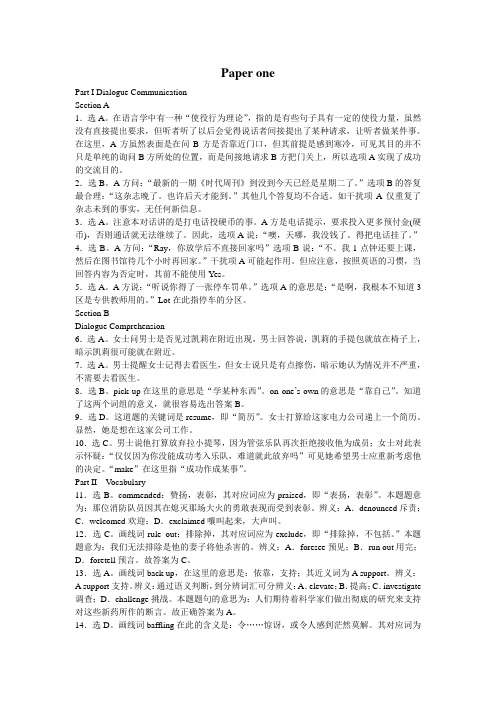
Paper onePart I Dialogue CommunicationSection A1.选A。
在语言学中有一种“使役行为理论”,指的是有些句子具有一定的使役力量,虽然没有直接提出要求,但听者听了以后会觉得说话者间接提出了某种请求,让听者做某件事。
在这里,A方虽然表面是在问B方是否靠近门口,但其前提是感到寒冷,可见其目的并不只是单纯的询问B方所处的位置,而是间接地请求B方把门关上,所以选项A实现了成功的交流目的。
2.选B。
A方问:“最新的一期《时代周刊》到没到今天已经是星期二了。
”选项B的答复最合理:“这杂志晚了。
也许后天才能到。
”其他几个答复均不合适。
如干扰项A仅重复了杂志未到的事实,无任何新信息。
3.选A。
注意本对话讲的是打电话投硬币的事。
A方是电话提示,要求投入更多预付金(硬币),否则通话就无法继续了。
因此,选项A说:“噢,天哪,我没钱了。
得把电话挂了。
”4.选B。
A方问:“Ray,你放学后不直接回家吗”选项B说:“不。
我1点钟还要上课,然后在图书馆待几个小时再回家。
”干扰项A可能起作用。
但应注意,按照英语的习惯,当回答内容为否定时,其前不能使用Yes。
5.选A。
A方说:“听说你得了一张停车罚单。
”选项A的意思是:“是啊,我根本不知道3区是专供教师用的。
”Lot在此指停车的分区。
Section BDialogue Comprehension6.选A。
女士问男士是否见过凯莉在附近出现,男士回答说,凯莉的手提包就放在椅子上,暗示凯莉很可能就在附近。
7.选A。
男士提醒女士记得去看医生,但女士说只是有点擦伤,暗示她认为情况并不严重,不需要去看医生。
8.选B。
pick up在这里的意思是“学某种东西”。
on one’s own的意思是“靠自己”。
知道了这两个词组的意义,就很容易选出答案B。
9.选D。
这道题的关键词是resume,即“简历”。
女士打算给这家电力公司递上一个简历。
显然,她是想在这家公司工作。
在职申硕同等学力英语真题及答案

在职申硕同等学力英语真题及答案一、听力部分本部分共有四个小节,每个小节听两遍。
第一节:听下面一段对话,回答问题。
现在你有5秒钟的时间阅读题目。
问题:What is the woman planning to do tomorrow?答案:She is planning to go shopping.解析:从对话中可以听出,女士打算明天去购物。
第二节:听下面一段对话,回答问题。
现在你有5秒钟的时间阅读题目。
问题:Where does the conversation take place?答案:In a restaurant.解析:从对话中可以听出,这段对话是在一个餐厅进行的。
第三节:听下面一段对话,回答问题。
现在你有5秒钟的时间阅读题目。
问题:What is the woman doing this weekend?答案:She is going to visit her parents.解析:从对话中可以听出,女士计划这个周末去看望她的父母。
第四节:听下面一段对话,回答问题。
现在你有5秒钟的时间阅读题目。
问题:What will the man do next?答案:He will go to the bank.解析:从对话中可以听出,男士接下来要去银行。
二、阅读部分本部分共有三个小节,阅读每篇短文后回答相关问题。
第一节:阅读短文,回答问题。
现在你有15秒钟的时间阅读题目。
问题:What is the main purpose of the text?答案:To introduce a newly-opened restaurant.解析:从短文中可以看出,文章的主要目的是介绍一家新开的餐厅。
第二节:阅读短文,回答问题。
现在你有15秒钟的时间阅读题目。
问题:What do we learn about Antonio in the text?答案:He used to live in the UK.解析:从短文中可以得知,Antonio曾经住在英国。
2010年考研英语二真题全文翻译答案超详解析
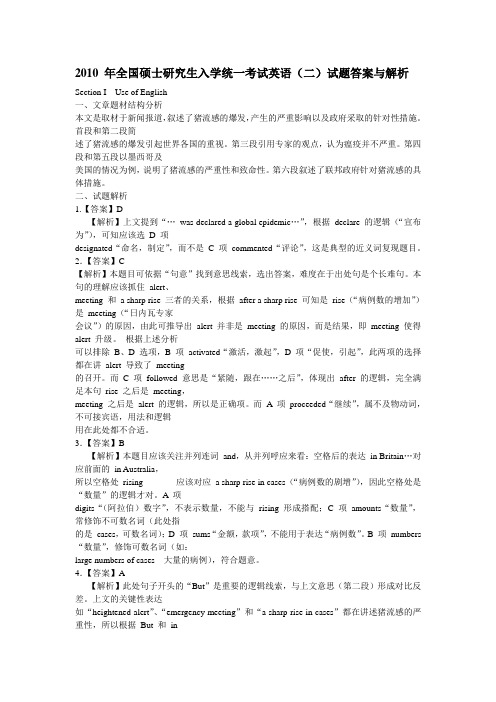
2010 年全国硕士研究生入学统一考试英语(二)试题答案与解析Section I Use of English一、文章题材结构分析本文是取材于新闻报道,叙述了猪流感的爆发,产生的严重影响以及政府采取的针对性措施。
首段和第二段简述了猪流感的爆发引起世界各国的重视。
第三段引用专家的观点,认为瘟疫并不严重。
第四段和第五段以墨西哥及美国的情况为例,说明了猪流感的严重性和致命性。
第六段叙述了联邦政府针对猪流感的具体措施。
二、试题解析1.【答案】D【解析】上文提到“…was declared a global epidemic…”,根据declare 的逻辑(“宣布为”),可知应该选D 项designated“命名,制定”,而不是C 项commented“评论”,这是典型的近义词复现题目。
2.【答案】C【解析】本题目可依据“句意”找到意思线索,选出答案,难度在于出处句是个长难句。
本句的理解应该抓住alert、meeting 和a sharp rise 三者的关系,根据after a sharp rise 可知是rise(“病例数的增加”)是meeting(“日内瓦专家会议”)的原因,由此可推导出alert 并非是meeting 的原因,而是结果,即meeting 使得alert 升级。
根据上述分析可以排除B、D 选项,B 项activated“激活,激起”,D 项“促使,引起”,此两项的选择都在讲alert 导致了meeting的召开。
而C 项followed 意思是“紧随,跟在……之后”,体现出after 的逻辑,完全满足本句rise 之后是meeting,meeting 之后是alert 的逻辑,所以是正确项。
而A 项proceeded“继续”,属不及物动词,不可接宾语,用法和逻辑用在此处都不合适。
3.【答案】B【解析】本题目应该关注并列连词and,从并列呼应来看:空格后的表达in Britain…对应前面的in Australia,所以空格处rising _____ 应该对应a sharp rise in cases(“病例数的剧增”),因此空格处是“数量”的逻辑才对。
2010年同等学力申硕统一考试英语真题(B卷)
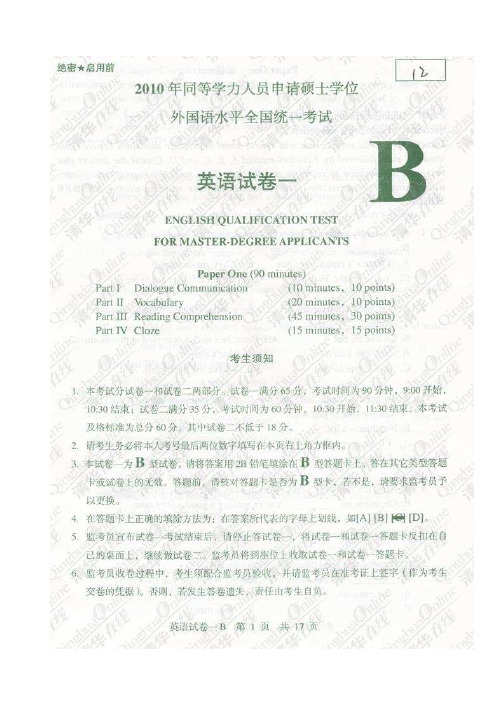
Part ⅠTranslation (30 minutes, 20 points, 10 for each section)Section ADirections: Translate the following passage into Chinese. Write your translation on the ANSWER SHEET.An ecosystem is a group of animals and plants living in a specific region and interacting with one another and with their physical environment. Ecosystems include physical and chemical components, such as soils, water, and nutrients that support the organisms living there. These organisms may range from large animals to microscopic bacteria.Ecosystems also can be thought of as the interactions among all organisms in a given area: for instance, one species may serve as food for another. People are part of the ecosystems where they live and work. Human activities can harm or destroy local ecosystems unless actions such as land development for housing or businesses are carefully planned to conserve and sustain the ecology of the area.Section BDirections: Translate the following passage into English. Write your translation on the ANSWER SHEET.全球化作为一种新的经济和社会发展趋势,给中国带来了机遇,也带来了挑战,—方面,中国正成为世界制造业中心并在国家舞台上发挥着日益重要的作用;另—方面,我们也面临着如何在全球化进程中既要发展经济,又能传承优秀文化传统的问题。
2010年同等学力英语真题解析
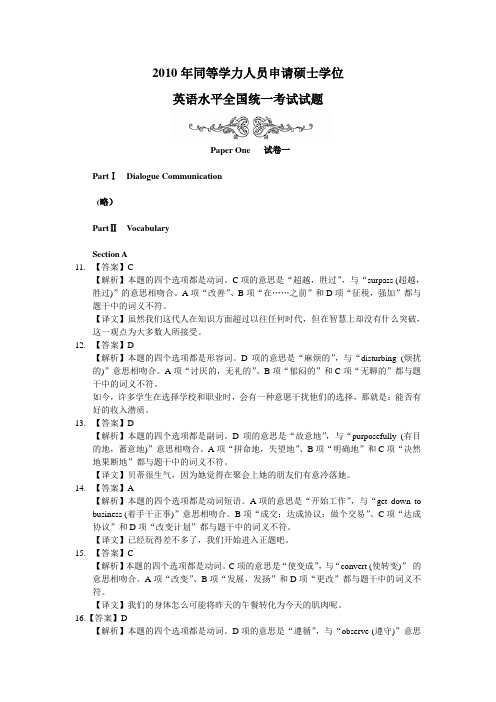
2010年同等学力人员申请硕士学位英语水平全国统一考试试题Paper One 试卷一PartⅠDialogue Communication(略)PartⅡVocabularySection A11. 【答案】C【解析】本题的四个选项都是动词。
C项的意思是“超越,胜过”,与“surpass (超越,胜过)”的意思相吻合。
A项“改善”、B项“在……之前”和D项“征税,强加”都与题干中的词义不符。
【译文】虽然我们这代人在知识方面超过以往任何时代,但在智慧上却没有什么突破,这一观点为大多数人所接受。
12. 【答案】D【解析】本题的四个选项都是形容词。
D项的意思是“麻烦的”,与“disturbing (烦扰的)”意思相吻合。
A项“讨厌的,无礼的”、B项“郁闷的”和C项“无聊的”都与题干中的词义不符。
如今,许多学生在选择学校和职业时,会有一种意愿干扰他们的选择,那就是:能否有好的收入潜质。
13. 【答案】D【解析】本题的四个选项都是副词。
D项的意思是“故意地”,与“purposefully (有目的地,蓄意地)”意思相吻合。
A项“拼命地,失望地”、B项“明确地”和C项“决然地果断地”都与题干中的词义不符。
【译文】贝蒂很生气,因为她觉得在聚会上她的朋友们有意冷落她。
14. 【答案】A【解析】本题的四个选项都是动词短语。
A项的意思是“开始工作”,与“get down to business (着手干正事)”意思相吻合。
B项“成交;达成协议;做个交易”、C项“达成协议”和D项“改变计划”都与题干中的词义不符。
【译文】已经玩得差不多了,我们开始进入正题吧。
15. 【答案】C【解析】本题的四个选项都是动词。
C项的意思是“使变成”,与“convert (使转变)”的意思相吻合。
A项“改变”、B项“发展,发扬”和D项“更改”都与题干中的词义不符。
【译文】我们的身体怎么可能将昨天的午餐转化为今天的肌肉呢。
16.【答案】D【解析】本题的四个选项都是动词。
2010同等学力申硕英语真题答案
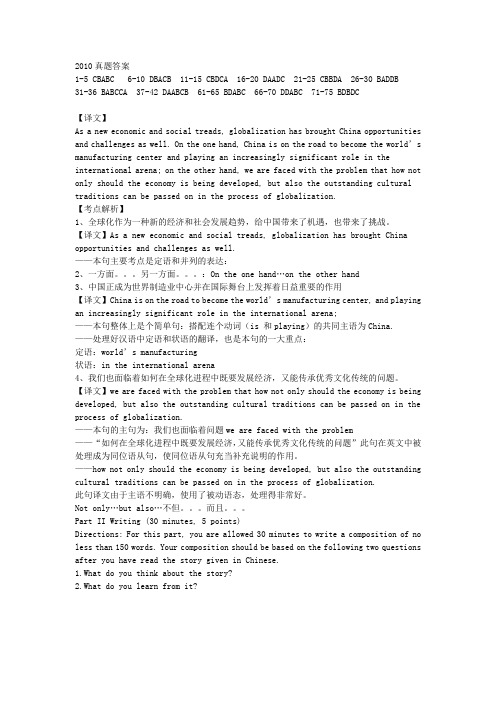
2010真题答案1-5 CBABC 6-10 DBACB 11-15 CBDCA 16-20 DAADC 21-25 CBBDA 26-30 BADDB31-36 BABCCA 37-42 DAABCB 61-65 BDABC 66-70 DDABC 71-75 BDBDC【译文】As a new economic and social treads, globalization has brought China opportunities and challenges as well. On the one hand, China is on the road to become the world’s manufacturing center and playing an increasingly significant role in the international arena; on the other hand, we are faced with the problem that how not only should the economy is being developed, but also the outstanding cultural traditions can be passed on in the process of globalization.【考点解析】1、全球化作为一种新的经济和社会发展趋势,给中国带来了机遇,也带来了挑战。
【译文】As a new economic and social treads, globalization has brought China opportunities and challenges as well.——本句主要考点是定语和并列的表达:2、一方面。
另一方面。
:On the one hand…on the other hand3、中国正成为世界制造业中心并在国际舞台上发挥着日益重要的作用【译文】China is on the road to become the world’s manufacturing center, and playing an increasingly significant role in the international arena;——本句整体上是个简单句:搭配连个动词(is 和playing)的共同主语为China. ——处理好汉语中定语和状语的翻译,也是本句的一大重点:定语:world’s manufacturing状语:in the international arena4、我们也面临着如何在全球化进程中既要发展经济,又能传承优秀文化传统的问题。
同等学力申硕英语考试 PPT课件

• 此部分要求考生能够综合运用英语语言知 识和阅读技能, 读懂一般性题材的文章即 科技文献;要求能抓住大意。读懂细节, 能理解上下文的逻辑联系,并领会作者的 意图和态度。
8
• Part 4 Cloze • 本部分共设10~15题,每题1分。考试时间为
10~15分钟。本部分设两种题型,每次考试设其 中一种题型。
考试题型
1
• 本考试分试卷一和试卷二。试卷一以客观 试题为主;试卷二为主观试题。两卷满分 为100分。试卷一占总分的65%,试卷二占 总分的35%;达到总分的60%为及格。试 卷二得分低于18者,不论试卷一得分多少, 均为不及格。
2
Part 1 Dialogue • 能用英语进行C日o常m会话m;u对于n生ic活a、t学io习n、工作中的常见
2. Researchers shows heavy coffee drinking is ________ a small increase in blood pressure, but not enough to increase the risk for high blood pressure.
B: _________ Actually I’ve been on a diet and I’ve been doing a keep-fit class too.
A. No, thanks.
同等学力英语会话技能解题十大思路

同等学力英语会话技能解题十大思路
2012年5月27日的同等学力考试在即。
英语科目一直是广大考生备考的重点和难点。
根据多年考试辅导经验,新东方网络课堂同等学力辅导老师提醒大家,会话技能部分是最容易得分的题目,所以要保证不丢分。
以下十大解题思路希望能对大家的得分有所帮助。
技巧小贴士:不礼貌的答案不入选、直接拒绝的不如选、选择委婉、符合西方文化及价值观念的答案。
十种解题思路:1、在整个题型的所有对话当中,所有的对话都是来自于我们生活的交际情景。
这些情景主要分为5个方面:衣食住行;日常生活(邮局,银行,锻炼,互相问候);人际关系;学习和工作方面;娱乐消遣方面(音乐会,电影院,看电视,外出野餐,旅行,度假等)。
2、交际中的语法不同于我们通常所说的语法,它是我们做出正确选项判断的依据。
3、做到回答句中前后一致。
4、交际当中不能够答非所问。
5、注意在一个自然的交际状态下的语言的逻辑,语言的逻辑主要通过交际当中的连接词来体现的。
像but,although,however,what’smore等词。
6、除开语法、逻辑和交际情景特色词汇等特殊的情况下,必须要符合合情合理的原则。
7、注意前后的语气:表示高兴的语
气词:wow,Gee;表示不太高兴的,震惊的,推诿的语气词:Well,Jesus,Oh!god,gosh,Uh-oh;表示疼痛的词语:Ouch;表示失去耐心了:Oh,boy!Oh,man!8、要符合西方交际的文化和习惯,以及表达方式。
9、应该符合西方的价值观念。
10、主要针对SectionB:通过真题和模拟题总结常用成语和习惯用法,并记住,培养语感。
同等学力申请硕士学位外国语全国统一考试试题及答案

同等学力申请硕士学位外国语全国统一考试试题及答案一、综合能力测试综合能力测试是同等学力申请硕士学位外国语全国统一考试的重要组成部分,考察考生在语言运用、阅读理解、写作等方面的能力。
下面是一套典型的综合能力测试试题及答案供考生参考。
第一节语言运用阅读下面的短文,然后根据短文内容选择最佳答案。
Some animals, such as camels and desert snakes, are incredibly good at surviving in the desert. Their adaptations (适应) 1 them to live in conditions that other creatures couldn't cope with.Camels are known for their humps, which are a store of fat that can be converted into water and energy when food and water are scarce. Their wide, tough feet help them to walk easily on sand, and their long legs allow them to take big steps to avoid sinking.Desert snakes have a special way of moving across the hot desert sand. Unlike most snakes, which push themselves off the ground with their stomach muscles, desert snakes do the opposite. They lift their stomachs off the ground to the point where they almost stand up and then they throw themselves forwards. This way of moving is very quick and allows the snake to spend less time in contact with the burning sand.1. The main topic of the passage is __________.A. adapting to desert conditionsB. the humps of camelsC. the movement of desert snakesD. the features of camels and desert snakes答案:D2. According to the passage, camels can __________.A. store water in their humpsB. convert fat into foodC. walk easily on sandD. take big steps to avoid sinking答案:C3. How do desert snakes move across the hot sand?A. By lifting their stomachs off the ground.B. By pushing themselves off the ground with their stomach muscles.C. By throwing themselves forwards quickly.D. By spending less time in contact with the sand.答案:A二、阅读理解阅读下面的短文,根据短文内容选择最佳答案。
2010同等学力申硕英语模拟题九答案
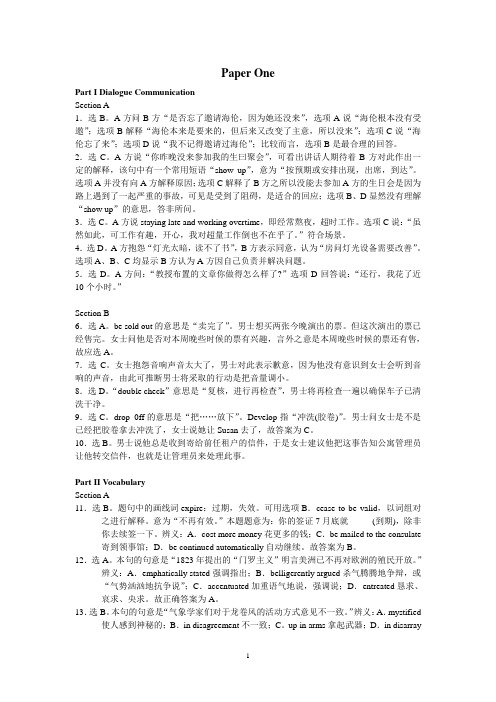
Paper OnePart I Dialogue CommunicationSection A1.选B。
A方问B方“是否忘了邀请海伦,因为她还没来”,选项A说“海伦根本没有受邀”;选项B解释“海伦本来是要来的,但后来又改变了主意,所以没来”;选项C说“海伦忘了来”;选项D说“我不记得邀请过海伦”;比较而言,选项B是最合理的回答。
2.选C。
A方说“你昨晚没来参加我的生曰聚会”,可看出讲话人期待着B方对此作出一定的解释,该句中有一个常用短语“show up”,意为“按预期或安排出现,出席,到达”。
选项A并没有向A方解释原因;选项C解释了B方之所以没能去参加A方的生日会是因为路上遇到了一起严重的事故,可见是受到了阻碍,是适合的回应;选项B、D显然没有理解“show up”的意思,答非所问。
3.选C。
A方说staying late and working overtime,即经常熬夜,超时工作。
选项C说:“虽然如此,可工作有趣,开心,我对超量工作倒也不在乎了。
”符合场景。
4.选D。
A方抱怨“灯光太暗,读不了书”,B方表示同意,认为“房问灯光设备需要改善”。
选项A、B、C均显示B方认为A方因自己负责并解决问题。
5.选D。
A方问:“教授布置的文章你做得怎么样了?”选项D回答说:“还行,我花了近10个小时。
”Section B6.选A。
be sold out的意思是“卖完了”。
男士想买两张今晚演出的票。
但这次演出的票已经售完。
女士问他是否对本周晚些时候的票有兴趣,言外之意是本周晚些时候的票还有售,故应选A。
7.选C。
女士抱怨音响声音太大了,男士对此表示歉意,因为他没有意识到女士会听到音响的声音,由此可推断男士将采取的行动是把音量调小。
8.选D。
“double check”意思是“复核,进行再检查”,男士将再检查一遍以确保车子已清洗干净。
9.选C。
drop 0ff的意思是“把……放下”。
Develop指“冲洗(胶卷)”。
同等学力申硕法语2010真题答案

2010年同等学力申硕全国统考法语试卷作者:佚名来源:本站原创日期:2011-3-17 10:18:37法语试卷一I. Pratique communicative (10 points, 15 minutes)II. Structure grammaticale et vocabulaire (20 points, 20 minutes)III. Compréhension écrite (30 points, 40 minutes)IV. Exercice à trous (10 points, 15 minutes)考生须知1.本考试分试卷一和试卷二两部分。
试卷一满分70分,考试时间为90分钟,9:00开始,10:30 结束;试卷二满分30 分,考试时间为60 分钟,10:30 开始,11:30 结束。
本考试及格标准为总分60分,其中试卷二不低于16分。
2.请考生务必将本人考号最后两位数字填写在本页右上角方框内。
3.本试卷一为A 型试卷,请将答案用2B铅笔填涂在A 型答题卡上,答在其它类型答题卡或试卷上的无效。
答题前,请核对答题卡是否为 A 型卡,若不是,请要求监考员予以更换。
4.在答题卡上正确的填涂方法为:在答案所代表的字母上划线,如[A] [B] [C] [D]。
5.监考员宣布试卷一考试结束后,请停止答试卷一,将试卷一和试卷一答题卡反扣在自己的桌面上,继续做试卷二。
监考员将到座位上收取试卷一和试卷一答题卡。
6.监考员收卷过程中,考生须配合监考员验收,并请监考员在准考证上签字(作为考生交卷的凭据)。
否则,若发生答卷遗失,责任由考生自负。
法语试卷一A 第 1 页共11 页I. Pratique communicative (10 points)Choisissez la meilleure proposition pour compléter les dialogues.1. -- _ , monsieur, l’arrêt du 21, c’est de quel côté?Il y a bien un arrêt de bus, mais ce n’est pas le 21, c’est le 61.A) DésoléB) Je vous en remercieC) Je regretteD) Pardon2. -- Ça va, monsieur? ?J’ai glissé sur quelque chose et je suis tombé.Vous vous êtes fait mal?Un peu, oui, j’ai mal au genou.A) Qu’est-ce qui vous est arrivéB) Où avez-vous malC) Tout va bienD) Ce n’est pas grave3. -- Bonjour, ?Non, monsieur, vous avez fait erreur. Je ne suis pas Mme Granger.Excusez-moi, madame, je me suis trompé de numéro.A) voici la maison de Mme GrangerB) c’est la famille de Mme GrangerC) je suis bien chez Mme GrangerD) est-ce que je suis bien à la maison de Mme Granger4. -- Madame, ?Oui, monsieur. Voilà, je suis furieuse, parce que j’ai acheté cet ordinateur il y aune semaine et qu’il est déjà en panne! Il ne marche plus.Comment ça, il ne marche pas?Oui, je dis bien : il ne marche pas.Je vais voir.A) j’aimerais bien vous aiderB) je peux vous aiderC) je veux vous aiderD) je devrais vous aider法语试卷一A 第 2 页共11 页5. -- Vincent, regarde ce que j’ai fait J’ai cassé le verre !_ , Aurélie !Je suis vraiment désolée, c’est ma faute, je suis tellement maladroite.Ecoute, je te dis que ce n’est rien.A) Je vous en prieB) C’est bien regrettableC) Ce n’est pas graveD) C’est gentil6. -- Ça te dirait de partir à la mer?Ah oui, !Mais si on s’arrête chez ma mère, sur le chemin?Pas de problème, elle est sympa, ta mère.A) pas malB) c’est gentilC) avec plaisirD) je vous en prie7. -- Félix, qu’est-ce que vous faites, samedi? Vous ne voulez pas venir dîner, Aude et toi?Non, , samedi, on ne peut pas, on n’est pas là.A) c’est bienB) c’est dommageC) pardonD) pas de problème8. -- Vous voulez un café?Non, , je vous remercie!Alors, un biscuit?Non, merci.A) c’est gentilB) pardonC) vous seriez aimableD) je suis désolé法语试卷一A 第 3 页共11 页9. -- Tu veux que je t’aide à porter cette valise ?Non, non, . Elle n’est pas lourde.Mais je pensais que tu avais mal au dos.Mais non, pas du tout! Je n’ai jamais mal au dos.A) il n’y a pas de problèmeB) il n’y a rien de graveC) ce n’est pas obligatoireD) ce n’est pas la peine10. -- Bon,tu viens ou tu ne viens pas ?Bof ! Je ne sais pas trop j’hésite_ . Ça va commencer.A) Dépêche-toiB) Je vous en prieC) D’accordD) Bon, benII. Structure grammaticale et vocabulaire (20 points)Complétez les phrases suivantes en choisissant A, B, C, D. Faites le meilleur choix parmi ces quatre pr opositions.11. Je cherche la bibliothèque du quartier. Pourriez-vous me dire elle se trouve?A) qui B) qu’C) où D) dont12. Depuis la crise, trois Français quatre ont peur de perdre leur emploi.A) sur B) parmiC) chez D) pour13. Au bout d’une semaine d’observation, le médecin a constaté que son maladedes forces.A) a repris B) reprendraC) reprenne D) avait repris14. Selon le règlement de ce foyer de jeunes, il ne faut pas que les locataires lacuisine dans la chambre.A) font B) fassentC) feraient D) feront15. Au moment de payer, Alice qu’elle avait oubliéd’apporter sonporte-monnaie. C’est vraiment désagréable!A) a aperçu B) est aperçueC) s’est aperçu D) s’est aperçue法语试卷一A 第 4 页共11 页16. Notre guide y a mis ardeur qu’il a fini par nous convaincre.A) beaucoup d’ B) bien d’C) tant d’ D) tellement17. Je ne me souviens plus j’ai laissé les magazines français que Catherinem’avait donnés.A) où B) quiC) que D) dont18. Je suis chez moi aujourd’hui et j’aimerais bien manger avec toi. Tu peux venirn’importe .A) qui B) quandC) où D) comment19. Votre mère travaille encore? – Non, elle ne travaille , elle est à la retraite depuis l’année dernière.A) pas B) plusC) jamais D) point20. 《Les quatre saisons》est une chanson populaire j’adore la mélodie.A) que B) ce queC) dont D) où21. Ce jour-là, Madame Li a préparé cinq plats pour ses étudiantes étrangères, étaient délicieux.A) qui B) tousC) ceux qui D) toutes22. Nicolas l’ impression que tout le monde avait accepté sa proposition.A) a B) auraC) avait D) aurait23. Est-ce que ton copain t’a apporté des fromages francais? – Oui, il à son retour de France.A) m’en a apporté B) me les a apportéC) m’en a apportés D) me l’a apporté24. Maintenant, de plus en plus de personnes préfèrent s’installer en banlieue loyer élevé et de la grave pollution au centre ville.A) en plus du B) par suite duC) sous prétexte du D) en raison du25. Grâce à vous j’ai trouvé un emploi qui mes compétences.A) intéresse B) influenceC) contribue à D) correspond à26. As-tu vu le président de l’université qui se trouve les nouveaux étudiants?A) entre B) avecC) parmi D) vers法语试卷一A 第 5 页共11 页27. Attendez un instant! Fanny n’a pas encore choisi son sac à dos, il y en a qui lui plaisent.A) tout B) certainsC) quelques-unes D) plusieurs28. Virginie a enfin trouvé une grande chambre claire et calme sur le jardin, en plus, le loyer n’est pas du tout élevé.A) donnant B) en donnantC) donne D) donnée29. Louis continue ses études dans l’université, ses parents ne lui donnent plus d’argent.A) encore que B) bien queC) quoi que D) quel que30. Il faut connaître une chose: en France, il n’est pas de faire visiter sachambre aux invités.A) poli B) gentilC) habituel D) habileIII. Compréhension écrite (30 points)Lisez les textes suivants et choisissez la meilleure réponse parmi les quatre propositions.Texte 1L’enseignement assisté par l’ordinateur« Au moins il est gentil. Avec lui, on peut se tromper ; il ne nous gronde jamais. » Dans la bouche d’un enfant de sept ans, cette petite phrase illustre un aspectintéressant de l’E.A.O.–l’enseignement assisté par ordinateur. L’E.A.O. révolutionne le rapport enseig nant-enseigné, et ce n’est làqu’un de ces avantages. Pourtant, l’ E.A.O. ne jouit pas d’une très bonne réputation dans les milieux enseignants – dans le primaire en particulier. La preuve ? Jean-Yves Chateau, conseiller informatique de la direction des écoles au Ministère de l’Education nationale, déclarait l’an dernier : «L’informatique est moins une réponse aux problèmes pédagogiques qu’un problème pédago gique nouveau. » Craignant l’impact de l’ordinateur dans le contexte où « la formation de l’esprit des je unes enfants est en jeu », Jean-Yves Chateau préconise de limiter le recours àl’ordinateur : il suffira d’éveiller les élèves à la culture informatiquedans le cadre d’une instruction civique (公民义务教育)nécessaire pour éviter leseffets négatifs de l’informatisation ».法语试卷一A 第 6 页共11 页Evoquant le plan qui vise à doter l’Education nationale de cent mille micro-ordinateurs, Jean-Yves Château mettait en garde contre les dangers d’une introduction hâtive de l’ordinateur àl’école : « les travau x les plus récents sur les technologies éducatives laissent dans le doute et l’inquiétude sur leur caractère immédiatement démocratique. »Questions :31. Pourquoi les enfants de sept ans disent-ils que l’ordinateur est gentil ? Parce que(qu’) .A) avec l’ordinateur, on ne peut pas se tromper B) avec l’ordinateur, on ne se trompe jamaisC) l’ordinateur ne demande jamais aux enfants de répondre aux questions D) l’ordinateur ne critique ja mais avec violence les enfants32. D’après le texte, l’un des avantages de l’enseignement assisté par ordinateur, c’e stqu’il .A) modifie profondément les relations entre les enseignants et leurs élèves B) facilite le travail des ense ignants et des élèvesC) prépare les élèves à tous les examensD) forme les enseignants de manière qu’ils s’habituent à une nouvelle pédagogie33. Quelle est la profession de Jean-Yves Chateau ? Il est .A) fonctionnaire chargé de l’utilisation des ordinateurs dans l’enseignement B) directeur d’une école dépendant du Ministère de l’Education nationaleC) enseignant dans une école primaireD) professeur d’informatique dans une grande école34. Qu’est-ce que c’est que l’informatisation ici dans le texte ? C’est .A) l’introduction de l’ordinateur dans l’enseignement primaire B) l’instruction pour l’utilisation de l’or dinateurC) l’utilisatio n excessive de l’ordinateurD) l’enseignement de l’informatique35. Quelle est l’attitude de Jean-Yves Chateau devant l’enseignement assisté parordinateur ?A) Il le déteste.B) Il est pour sans réserve.C) Il espère accélérer l’introduction de l’ordinate ur àl’école.D) Il déconseille une introduction rapide de l’ordinateur àl’école.法语试卷一A 第7 页共11 页Texte 2Un épuisant va-et-vient journalierLa grande masse des habitants de la banlieue parisienne subit le rythme des horaires des trains et des au tobus de banlieue qu’il faut attendre souvent assez longtemps en raison de la grande quantité de passag ers. Pendant toute la mauvaise saison, c’est le départ à la nuit noire, la course jusqu’à la gare ou jusqu’à la station d’autobus, le trajet aveugle et chaotique au sein d’une foule serrée, mouillée de pluie, l’arrivée à une gare ou à une porte de Paris oùl’on plonge dans le métro tiède. Et c’est enfin le lieu du travail. Beaucoup évitent de rentrer à la maison à midi, ils ne le peuvent matériellement pas. Le déjeuner sera p ris dans une cantine d’entreprise ou dans un petit restaurant de quartier. Le soir, c’est une course non m oins folle que le matin. La plupart des travailleurs sortent à 18 heures ; avec de la chance le voyage et l a journée s’achèventvers 19 heures ou 19 heures 30. Et il faut encore s’occuper du ménage et du dînerL’heureu x possesseur d’un pavillon et d’un jardinet de banlieue ne les voit que le samedi et le dimanch e. De toute façon, il a peu de temps à y passer, surtout, et cela est fréquent, s’il ajoute à son activité prof essionnelle principale des heures supplémentaires, ou une activité annexe qui le retiennent hors de chez lui jusqu’à 21 ou 22 herues.Questions :36. Dans le texte, « Un épuisant va-et-vient journalier », «épuisant » signifie .A) très fréquentB) très fatigantC) très rapideD) très nombreux37. Dans la première phrase du texte, « en raison de » veut dire .A) selonB) en dépit deC) à cause deD) grâce à38. Dans la phrase : « Pendant toute la mauvaise saison, oùl’on plonge dans le métrotiède », « la mauvaise saison » désigne .A) l’été où il fait trop chaud et la journée est trop longue B) l’hiver où les jours sont courts et il pleut so uventC) le printemps où il y a du ventD) l’automne où il y a des orages法语试卷一A 第8 页共11 页39. D’après le texte, pourquoi beaucoup de travailleurs ne rentrent-ils pas à la maison àmidi ? Parce que (qu’) .A) le temps est trop court pour qu’ils rentrent à la maisonB) il n’y a pas d’autobus leur permettant de rentrer chez eux C) la direction ne leur permet pas de rentre rD) ils préfèrent faire la sieste40. Pourquoi les habitants de la banlieue parisienne doivent-ils attendre souvent assezlongtemps les trains et les autobus ? Parce que (qu’) .A) il n’y a pas assez de trains ni d’autobusB) les intervalles entre les deux trains ou autobus sont irréguliers C) les trains et les autobus ne sont pas assez chersD) il y a trop de mondeTexte 3Napoléon et ParisSi Napoléon 1er, pour faire de Paris une capitale digne de son empire, poursuivit la construction du Lo uvre, créa les canaux de Paris, et fit édifier les arcs de triomphe du Carrousel et de l’Etoile, la colonne Vendôme et l’église de la Madeleine, c’est sous Napoléon III que Paris connut sa plus grande et import ante transformation.De gigantesques travaux d’urbanisme furent entrepris sous la direction de l’archi tecte Haussemann qui réaménagea Paris en perçant de larges boulevards dotés de trottoirs, en dégageant d’importants carrefo urs comme celui de la place de l’Etoile où, autour de l’Arc de triomphe, rayonnent douze avenues, dont la prestigeuse avenue Foch et les Champs-Elysées.Il confia à Alphand le soin d’aménager les Buttes-Chaumont, les bois de Boulogne et de Vincennes, aut refois chasses royales, et fit construire par Garnier le nouvel Opéral’une des plus belles réussites en pierre de cette époque et les principales garesparisiennes aux audacieuses charpentes métalliques, véritables cathédrales modernes.Cette architecture ordonnée, harmonieuse dans l’alignement et la symétrie de ses bâtiments en pierre de taille, aux façades abondamment décorées, fut àl’origine d’un urbanisme parisien lumineux et d’une i ncroyable transformation sur laquelle repose encore, pour une bonne part, l’organisation contemporaine de la ville.Les Champs-Elysées, qui n’étaient à la fin du 18e siècle, qu’un jardin sauvage, ont reçu depuis de beau x hôtels particuliers, des fontaines, des trottoirs, et connaissent les faveurs de la riche société. Les cafés -concerts attirent une foule élégante, encore plus dense les jours de courses à Longchamp ou lorsque s’i nstallent les expostions universelles.法语试卷一A 第9 页共11 页«L’aspect d’une ville change plus vite que le cœur d’un mortel », écrivait Baudelaire. Et, bien évidem ment, l’harmonie ne s’y établit pas spontanément. C’est pourquoi l’architecture et l’urbanisme doivent se rencontrer, tout comme le temps présent se doit de mettre en valeur les trésors du passé, sans perdre de vue les enjeux du siècle qui vient. A cet égard, Paris est exemplaire : l’ouverture vers l’ouest qui ava it été donnée aux Tuileries s’est transformée, à La Défense, en une porte sur l’avenir, selon le rêve d’un architecte danois, tandis qu’un autre architecte, sino-américain, a conçu une pyramide magique, inscriv ant le Louvre dans une continuité historique sans égale.Questions :41. Selon le texte, Napoléon 1er a fait construire pour que Paris devienne une capitale.A) aussi grandiose que son empireB) grandioseC) de l’empireD) aussi élargie que son empire42. Paris fut réaménagé par Haussemann .A) sous Napoléon 1erB) sous Napoléon IIIC) sous Napoléon 1er au lieu de Napoléon IIID) sous Napoléon 1er, et puis sous Napoléon III successivement43. Dans « Il confia à Alphand le soin autrefois chasses royales », « il » désigne.A) Napoléon 1erB) Napoléon IIIC) HaussemannD) l’empire44. Par «L’aspect d’une ville change plus vite que le cœur d’un mortel », Baudelairevoulait dire que .A) le cœur de l’homme est constantB) le cœur de l’homme est changeantC) une ville se transforme très vite, plus vite que le cœur de l’homme D) une ville dure aussi longtemps que le cœur de l’homme45. Selon le texte, si l’architecture et l’urbanisme doivent se rencontrer, c’est pour quela ville .A) se développe en harmonieB) puisse tenir compte dans son développement de l’avenir C) puisse tenir compte dans son développe ment du passé D) change avec le temps法语试卷一A 第10 页共11 页IV. Exercice à trous (10 points)Lisez le texte suivant et choisissez la meilleure réponse parmi les quatre propositions pour compléter le blanc.La France des monumentsLa France est riche 46 monuments qui font souvent la fierté de ses habitants. Paris a des monuments m erveilleux, et chaque région a47 , anciens ou modernes. Des grottes préhistoriques à la pyramide de verre du Louvre, tous racontent l ’histoire du pays et c’est pourquoi ils 48 une place importante dans le cœur des Français. Une fois par a n, àl’occasion de la Journée du patrimoine, de 49 monuments et musées ouvrent gratuitement leurs por tes à tousles visiteurs, 50 le Palais d’Élysées,résidence du Président de la République.Quel est le monument 51 visité à Paris ? La tour Eiffel évidemment, symbole de France, est le monume nt le plus populaire, mais il y en a bien d’autres, à Paris 52 en province : des châteaux, des cathédrales, des villes fortifiées entourées de remparts, des arcs de triomphe, des monuments antiques 53 des théâtres et des opéras, il y en a pour tous les goûts et pour tous les niveaux. 54 arrivé en France, n’oubliez pas de visiter ces merveilleux monuments tant à Paris 55 en province. Alors, n’hésitez pas, venez visiter la France !46. A) en B) deC) par D) sur 47. A) la sienneB) les leursC) les siennesD) les siens48. A) fontB) occupentC) obtiennentD) reçoivent49. A) bien desB) beaucoup de C) nombreux D) tant de50. A) même B) de mêmeC) à même D) même si 51. A) beaucoupB) autantC) aussi D) le plus 52. A) même B) aussiC) qu’ D) comme 53. A) tel que B) tels queC) telle que D) telles que 54. A) Après B) DèsC) Une fois D) Parfois55. A) où B) qu’C) et D) comme法语试卷一A 第11 页共11 页绝密★启用前2010年同等学力人员申请硕士学位外国语水平全国统一考试法语试卷二V. Version (15 points, 30 minutes)VI. Expression écrite (15 points, 30 minutes)考生须知1.试卷二满分30分。
2010同等学力申硕英语真题解析
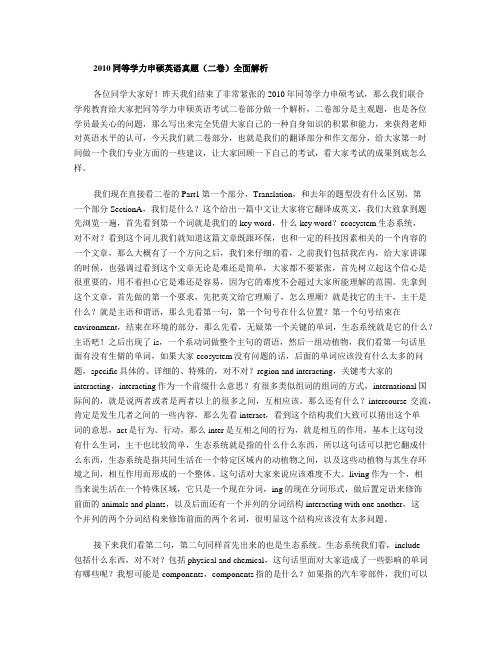
2010同等学力申硕英语真题(二卷)全面解析各位同学大家好!昨天我们结束了非常紧张的2010年同等学力申硕考试,那么我们联合学苑教育给大家把同等学力申硕英语考试二卷部分做一个解析,二卷部分是主观题,也是各位学员最关心的问题,那么写出来完全凭借大家自己的一种自身知识的积累和能力,来获得老师对英语水平的认可,今天我们就二卷部分,也就是我们的翻译部分和作文部分,给大家第一时间做一个我们专业方面的一些建议,让大家回顾一下自己的考试,看大家考试的成果到底怎么样。
我们现在直接看二卷的Part1第一个部分,Translation,和去年的题型没有什么区别,第一个部分SectionA,我们是什么?这个给出一篇中文让大家将它翻译成英文,我们大致拿到题先浏览一遍,首先看到第一个词就是我们的key word,什么key word?ecosystem生态系统,对不对?看到这个词儿我们就知道这篇文章既跟环保,也和一定的科技因素相关的一个内容的一个文章,那么大概有了一个方向之后,我们来仔细的看,之前我们包括我在内,给大家讲课的时候,也强调过看到这个文章无论是难还是简单,大家都不要紧张,首先树立起这个信心是很重要的,用不着担心它是难还是容易,因为它的难度不会超过大家所能理解的范围。
先拿到这个文章,首先做的第一个要求,先把英文给它理顺了,怎么理顺?就是找它的主干,主干是什么?就是主语和谓语,那么先看第一句,第一个句号在什么位置?第一个句号结束在environment,结束在环境的部分,那么先看,无疑第一个关键的单词,生态系统就是它的什么?主语吧!之后出现了is,一个系动词做整个主句的谓语,然后一组动植物,我们看第一句话里面有没有生僻的单词,如果大家ecosystem没有问题的话,后面的单词应该没有什么太多的问题,specific具体的、详细的、特殊的,对不对?region and interacting,关键考大家的interacting,interacting作为一个前缀什么意思?有很多类似组词的组词的方式,international国际间的,就是说两者或者是两者以上的很多之间,互相应该。
同等学力申硕英语水平考试历年真题及模拟题详解
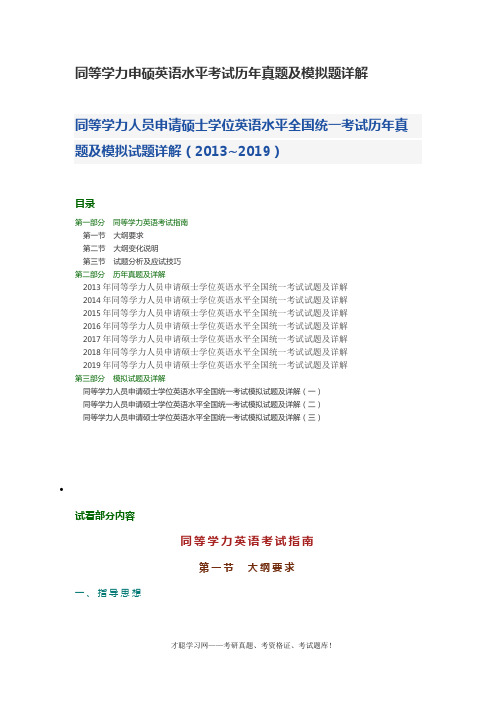
同等学力申硕英语水平考试历年真题及模拟题详解同等学力人员申请硕士学位英语水平全国统一考试历年真题及模拟试题详解(2013~2019)目录第一部分同等学力英语考试指南第一节大纲要求第二节大纲变化说明第三节试题分析及应试技巧第二部分历年真题及详解2013年同等学力人员申请硕士学位英语水平全国统一考试试题及详解2014年同等学力人员申请硕士学位英语水平全国统一考试试题及详解2015年同等学力人员申请硕士学位英语水平全国统一考试试题及详解2016年同等学力人员申请硕士学位英语水平全国统一考试试题及详解2017年同等学力人员申请硕士学位英语水平全国统一考试试题及详解2018年同等学力人员申请硕士学位英语水平全国统一考试试题及详解2019年同等学力人员申请硕士学位英语水平全国统一考试试题及详解第三部分模拟试题及详解同等学力人员申请硕士学位英语水平全国统一考试模拟试题及详解(一)同等学力人员申请硕士学位英语水平全国统一考试模拟试题及详解(二)同等学力人员申请硕士学位英语水平全国统一考试模拟试题及详解(三)•试看部分内容同等学力英语考试指南第一节大纲要求一、指导思想为了客观地测试以同等学力申请硕士学位人员(以下简称同等学力人员)的英语水平,保证学位授予的质量,根据国务院学位委员会办公室关于修订《同等学力人员申请硕士学位外国语水平全国统一考试大纲》的要求以及相关会议的精神,在总结近几年来同等学力人员英语水平统一考试经验的基础上,结合同等学力人员学习英语的特点,开展了第五次修订工作并形成新的考试大纲(第六版)。
本考试大纲要求通过教学使学生具有较好的用英语获取信息的能力和一定的用英语传递信息的能力。
这就要求考生具有较强的阅读理解能力,一定的口语交际能力和语篇信息处理能力,同时也必须具有一定的英译汉能力和写作能力。
本考试旨在测试考生是否达到大纲所规定的各项要求和具有大纲所规定的各项语言运用能力。
二、评价目标本考试重点考查考生的英语口语交际、阅读、语篇完形处理、英译汉和写作等技能(由于技术上的原因,本考试暂时取消听力测试,口语交际技能的测试采用书面形式进行。
2010-2017年同等学力英语真题及答案

How to Handle the StressNowadays more and more people have been under various stresses and there has been an increase in stress-related diseases among employees and students. This phenomenon has aroused immediate concern and widespread discussion among the general public. From my perspective, the resources of stresses can be from our work, family and also from the society, and learning how to deal with stresses has far-reaching significance to our body health.As a matter of fact, some solutions to reduce stresses can be illustrated below. The first one that comes to my mind readily is to share our stress with others. It can be enormously helpful because we may feel quite relaxed after talking to others and things even turn better if we get any valuable suggestions from them. What’s more, making time for fun such as listening to music and watching movies may be good medicine. Additionally, it is also a great way to reduce anxiety to do a large number of physical activities.From what has been discussed above, I strongly believe that we should know how to reduce enormous stress because it poses a general threat to human body health. As a common employee, I often feel immense stress at work. In those cases, I always tried to talk with my close friends to hear their advice or just listen to my favorite music. Only by having both mental and physical health can we hope to do our job well in the future?My favorite way of keeping fitsObservations and research findings indicate that people are increasingly concerned abo ut keeping fits. The importance people attach to it and the rapid development of related s ervices are the signs of this.There are several ways of keeping fits. Dieting should be fundamental to one’s heal th. We are facing more choice than ever before. Therefore, we should be cautious to sele ct the proper foods and to control the reasonable amount. What’s more, taking experienc e is another essential way. In addition, nobody is exposed to be considered as healthy in mental disorder, so that keeping mental health is also important.As for me, I am exerting all my strength on keeping my fits, by taking reasonable di eting and proper exercise and by remaining in good mind. In particular, I like jogging, m ore than four times per week, and approximately .Nowadays, more and more people are concerned about the problem of environmental protection, for the pollution has brought us so many bad influences. It is important for us to realize that it is everyone’s duty to protect our environment.To cope with this nation-wide problem, our government has started to take a series of effective measures. The most effective way is to save energy and reduce carbon emission. Because every year billions of tons of carbon dioxide are emitted into the air, which in part, result in the global warming and climate changing.For me, I am trying to make my own contributions. Firstly, I go to work by bus instead of driving. Secondly, I am getting to form the habit of saving water and electricity. For example, when I brush my teeth and wash my hands, I will never leave the water running again. What's more, I even recommend our relatives and friends to do so. By now my ways have been working perfectly and efficiently.Nowadays, with the rapid development of computer technology, in particular, the artificial intelligence (AI), the application of senior AI in the future has aroused a considerable world-wide concern. It is recently reported that in a ground-breaking fight between man and AI, the world champion of game Go was mercilessly defeated by Deep Mind Alpha Go, a product from Google, which gives rise to some people’s fear toward advanced AI i n future practice. And they take it for granted that human being would probably be totall y controlled by machine.As far as AI is concerned, I am fully convinced that we are supposed to maintain an obje ctive and positive attitude toward the emerging issue of artificial intelligence. It is know n to all that AI is nothing but the simulation of information on the process of conscious t hinking, or in another words, it’s something that subjects to its inventor’s design awaren ess. Consequently, as long as we are fully conscious of its possible disadvantages, certai n restrictions can be input into the program to avoid potential disastrous occurrences. Ad ditionally, it is well hoped that AI and intelligent machines can possibly free human labo rs from virtually all kinds of jobs. In that case/Above-mentioned discussion can safely le ad to the conclusion that what we are supposed to do is but to learn to get along with the inevitable development of computer technology and to adapt to the updated social struct ure changed by AI.What make happy couple happy?With the rapid development of modem society, an increasing number of people are c oncerned about the problem of the relationship between a husband and wife in our societ y. Not only the government but also the public have to pay more attention tothis phenomenon .Undoubtedly, it has brought about a great influence on people's work and living. Based on what has been discussed so far, it follows that some eflective solutions should be found to deal with the problem of the relationship between two people. On the one ha nd, the couples had better understand each other's daily habits so that they can form the s ame interests, which can make couples become happy on the other hand, no matter how close the relationship is between two people, we should give enough room to each other because keeping appropriate distance can make the two people more comfortable. Only i n these ways can we solve this problem successfully and eficctivcly.As far as I am concerned, no relationship will be free of difficulty or conflict. That happ y couples live happily is because that they are able to both apologize and forgive facing with difficulty or conflict.。
同等学历人员申请硕士学位英语-会话技能_真题(含答案与解析)-交互
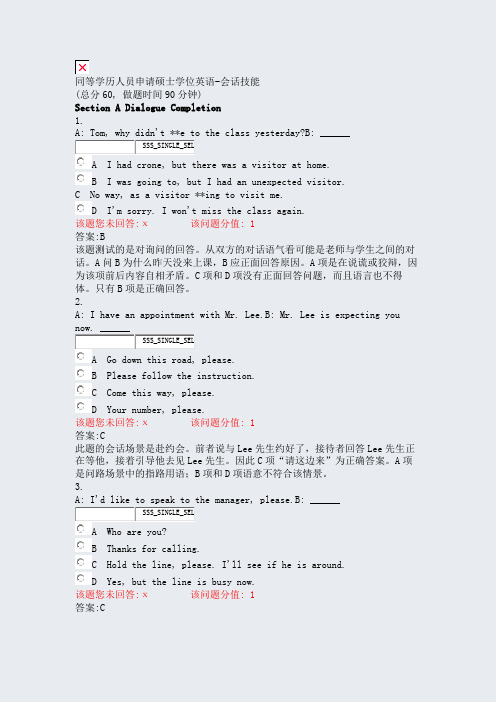
同等学历人员申请硕士学位英语-会话技能(总分60, 做题时间90分钟)Section A Dialogue Completion1.A: Tom, why didn't **e to the class yesterday?B: ______SSS_SINGLE_SELA I had crone, but there was a visitor at home.B I was going to, but I had an unexpected visitor.C No way, as a visitor **ing to visit me.D I'm sorry. I won't miss the class again.该题您未回答:х该问题分值: 1答案:B该题测试的是对询问的回答。
从双方的对话语气看可能是老师与学生之间的对话。
A问B为什么昨天没来上课,B应正面回答原因。
A项是在说谎或狡辩,因为该项前后内容自相矛盾。
C项和D项没有正面回答问题,而且语言也不得体。
只有B项是正确回答。
2.A: I have an appointment with Mr. Lee.B: Mr. Lee is expecting you now. ______SSS_SINGLE_SELA Go down this road, please.B Please follow the instruction.C Come this way, please.D Your number, please.该题您未回答:х该问题分值: 1答案:C此题的会话场景是赴约会。
前者说与Lee先生约好了,接待者回答Lee先生正在等他,接着引导他去见Lee先生。
因此C项“请这边来”为正确答案。
A项是问路场景中的指路用语;B项和D项语意不符合该情景。
3.A: I'd like to speak to the manager, please.B: ______SSS_SINGLE_SELA Who are you?B Thanks for calling.C Hold the line, please. I'll see if he is around.D Yes, but the line is busy now.该题您未回答:х该问题分值: 1答案:C此题考查打电话用语。
2010同等学力申硕英语真题试卷及答案解析
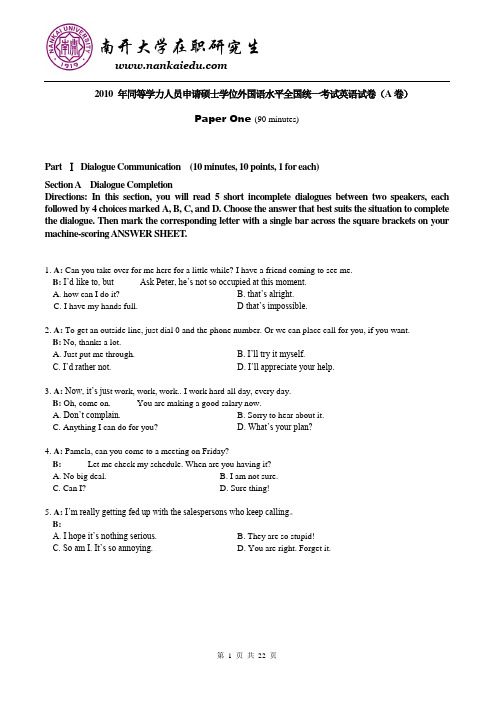
2010 年同等学力人员申请硕士学位外国语水平全国统一考试英语试卷(A卷)Paper One (90 minutes)Part ⅠDialogue Communication (10 minutes, 10 points, 1 for each)Section A Dialogue CompletionDirections: In this section, you will read 5 short incomplete dialogues between two speakers, each followed by 4 choices marked A, B, C, and D. Choose the answer that best suits the situation to complete the dialogue. Then mark the corresponding letter with a single bar across the square brackets on your machine-scoring ANSWER SHEET.1. A: Can you take over for me here for a little while? I have a friend coming to see me.B: I‟d like to, but _____ Ask Peter, he‟s not so occupied at this moment.A. how can I do it?B. that‟s alright.C. I have my hands full. D that‟s impossible.2. A: To get an outside line, just dial 0 and the phone number. Or we can place call for you, if you want.B: No, thanks a lot. _____A. Just put me through.B. I‟ll try it myself.C. I‟d rather not.D. I‟ll appreciate your help.3. A: Now, it‟s jus t work, work, work.. I work hard all day, every day.B: Oh, come on. _____ You are making a good salary now.A. Don‟t complain.B. Sorry to hear about it.C. Anything I can do for you?D. What‟s your plan?4. A: Pamela, can you come to a meeting on Friday?B: _____ Let me check my schedule. When are you having it?A. No big deal.B. I am not sure.C. Can I?D. Sure thing!5. A: I‟m really getting fed up with the salespersons who keep calling。
同等学力硕士题库考语用学笔记整理

语用学定义语境理论指示语理论、预设理论会话含义理论(合作原则、新格莱斯会话含义理论、言语行为理论(起源、经典理论、间接言语行为理论)、语用与文化、礼貌原则(含脸-面理论),并能运用这些理论来分析话语和会话。
★What is pragmatics?Pragmatics, a new subfield of linguistics, deals with particular utterances in particular situations and is especially concerned with the various ways in which the many social contexts of language performance can influence interpretation。
To be more specific, pragmatics is concerned with the following areas:⏹Pragmatics is the study of speaker meaning.⏹Pragmatics is the study of contextual meaning.⏹Pragmatics is the study of how more gets communicated than is said.e.g. :It’s hot in here. (please open the door/air-conditioner)⏹Is this your pen ? (can I borrow your pen?/ pick it up (request)⏹Tom had a chicken.(ate/ possessed/owned)⏹ A boy says to a girl “你不戴眼镜的时候很漂亮”,and the girl immediately responds “我戴眼镜的时候一定很丑了”.--- When we study language, we should pay attention to people, society, not language itself only.)★Context◆Example:I’ve got a flat tyre.In a garage, this might be taken to mean that I need help; or addressed to a friend with a car, that I need a lift; or as a response to a request for a lift from a friend without a car, that I cannot give him/her a lift.◆Types of context: linguistic context/co-text; situational context; social/cultural contextLinguistic context(上下文/言语语境) : It refers to specific parts of an utterance (or text) near or adjacent to a unit which is the focus of attention.e.g. bank1. used in a sentence together with words like steep or overgrown2. hear somebody say that she has to get to the bank to cash a checkSituational Context/physical context(情景语境)e.g. bankIf you see the word BANK on the wall of a building in a city, the “physical” location wil l influence your interpretation.→M.A.K Halliday’s theory of context of situation⏹Field(语场): what the language is being used to talk about;⏹tenor(超语言的,extra linguistic): the role relationships between the participants;⏹mode: the role language is playing in the interactionSocial/ cultural Context(约定俗成)e.g. A Fairy Tale⏹打招呼:英语(HOW ARE YOU?)汉语(你吃了吗?)★Deixis(指示语理论)Deixis is a technical term which means “pointing” via language.The meaning of deictic expressions cannot be captured by truth-conditional semantics, and their interpretation must depend on analysis of the context of utterance in which they occur.Main Points⏹D eixis directly concerns the relationship between the structure of language and the context in whichit is used.⏹Deictic expressions(指示/别语)or simply deictics refer to certain aspects of their context ofutterances, including the role of participants in the speech event and their spatio-temporal(空间-时间)and social location.⏹Five classes of deixis are presently recognized, namely person deixis(人称指示), place deixis, timedeixis, discourse deixis and social deixis.Two uses of deictics:⏹Gestural usesThe use of deictics together with paralinguistic(副语言特征,除语言以外的,non-verbal linguistic)features is called the gestural use.(e.g.: eye contact)e.g.He’s not the president. He is. He’s the secretary.Put the piano here. No, not here, but here.⏹Symbolic usesThe use of deictics without paralinguistic features is called the symbolic use.e.g.This city is highly congested.We can’t afford a holiday abroad this year.(exophoric reference)Types of deixis→Person deixis⏹Personal pronounsUnmarked(无标记的,standard, normal, basic) uses vs. marked uses(特殊用法)⏹Vocatives(称呼语)e.g. “ Do you understand?” ---(You : listener/ hearer; also some other people.)“你看电视好好的,他却把电视给关了”---这里的你,指说话人.“我们年青人应该多学点知识”--- 老师讲给学生,我们指的是你们.→Time deixis⏹Time adverbials: now, then, today, in three minutes , two days ago, etc.⏹Units of time: morning, week, month, etc.⏹Tense:⏹Note: calendar-time expressions (e.g. May 6,1987)are not considered deictic.→Place deixis⏹Here, there⏹This , that⏹Come , go; bring, take→Discourse(话语/语篇)deixis⏹This , that⏹But, therefore, in conclusion, to the contrary, besides, etc.⏹The last paragraph , the next sentence, the following section, the previous words, etc.→Social deixis⏹Social deixis is the use of deictic terms for indicating social status of the participants in a discourse,and their relations determined thereupon.⏹Honorifics(敬称)⏹tu vs. vous⏹du vs. Sie⏹你vs. 您★PresuppositionWhat is presupposition?⏹ A presupposition is something the speaker assumes to be the case prior to making an utterance.⏹Presuppositions are inferences about what is assumed to be true in the utterance rather than directlyasserted to be true (Peccei, J. 1999).e.g. Mary’s brother bought three hor ses.In producing the above utterance, the speaker will normally be expected to have the presuppositions that⏹ a person called Mary exists;⏹she has a brother;Constancy under negationBasically, it means that the presupposition of a statement will remain constant (i.e. still true) even when that statement is negated.e.g. Mary’s dog is cute presupposes that Mary has a dog. Mary’s dog isn’t cute also presupposes thatMary has a dog.Presupposition vs. entailmente.g. John managed to stop in time.From the example we can infer:John stopped in time.John tried to stop in time.Now take the negation of the example:John didn’t manage to stop in time.From this we cannot infer “John stopped in time.”, yet the inference to “John tried to stop in time.” is preserved and thus shared by the example sentence and its negative form.On the basis of the negation test, we identify that the presupposition of both the example sentence and its negative form is “John tried to stop in time.”, but not “John stopped in time.”.Clearly, the example sentence entails “John stopped in time.”, but its negative form does not entail it.Negation alters a sentence’s entailment, but it leaves the presuppositions untouched.⏹ A statement A presupposes another statement B iff:1) if A is true, then B is true.2) if A is false, then B is true.e.g. John is married.John exists.John is not married.John exists.⏹ A statement A entails another statement B iff:1) if A is true, then B is true.2) if A is false, then B may or may not be true.e.g. 1) That person is a bachelor.That person is a man.2) That person is not a bachelor.That person can be a man or awoman.Types of presupposition⏹Existential presupposition⏹Factive presupposition⏹Lexical presupposition⏹Structural presuppositions⏹Non-factive presupposition⏹Counter-factual presuppositionA property of presuppositionDefeasibility(可撤消性): In some contexts, a presupposition is defeasible.1. Linguistic factorse.g. John didn’t manage to pass the exam. >> John tried to pass the exam.But if uttered in the context,John didn’t manage to pass the exam. In fact he didn’t even try to.Add one more sentence, then the original presupposition is cancelled by the utterance “In fact he didn’t even try to”.2.Non-linguistic factorse.g. She cried before she finished writing the novel. >> She finished writing the novel.But in the utterance,She died before she finished writing the novel.the presupposition She finished writing the novel is cancelled by the common sense knowledge that if someone dies, he cannot write novels anymore.The projection problem(投射问题): The presuppositions of complex sentences are not equal to the combination of the presuppositions of all the sentences.(整体不等于部分之和)★Conversational implicatureMain points:⏹The important point made by Grice regarding the theory of implicature is the distinction betweenwhat is said and what is implicated.⏹The Cooperative Principle is very common not only in verbal communication but also in almost allhuman interactions, and it is followed reasonably, not compulsorily.⏹Conversational implicaturesWhat the hearer infers from the utterance that is not openly stated.Conversational implicature is based on the Cooperative Principle.In Grice’s analysis, the speaker’s flouting of a maxim combined with the hearer’s assumption that the speaker has not really abandoned the co-operative principle leads to an implicature.Generally ,conversational implicatures can be divided into two kinds: generalized and particularized.The cooperative principleMake your conversational contribution such as is required, at the stage at which it occurs, by the accepted purpose or direction of the speech exchange in which you are engaged.CP consists of four specific maxims.→Quantity1) Make your contribution as informative as is required(for the current purposes of the exchange ).2) Do not make your contribution more informative than isrequired.→QualityTry to make your contribution one that is true.1) Do not say what you believe to be false.2) Do not say that for which you lack adequate evidence.→RelationBe relevant.→MannerBe perspicuous1) Avoid obscurity of expression.2) Avoid ambiguity.3) Be brief (avoid unnecessary prolixity).4) Be orderly.◇The maxims of the cooperative principle can be used to describe how participants in a conversation derive implicatures. Grice gives the following example. A is standing by an obviously immobilized car and is approached by B. The following exchange takes place.A: I am out of petrol.B: There is a garage round the corner.A can deduce from B’s reaction thatB means that there is a garage around the corner that is open and sells gasoline. B, however,has not mentioned these facts. A can only make these assumptions if s/he assumes that B is acting in accordance with the cooperative principle and is adhering to the maxim of relevance.◇Features of conversational implicatures:1.cancellability( can be cancelled)2.non-detachability( we can change the form, but the meaning does n’t change, so the implicature doesn’tchange.)e.g.a-d said ironically will all implicate ea. John is a genius.b. John is a mental prodigy.c. John is an enormous intellect.d. John is a big brain.e. John is an idiot.3.Calculability可推导性(从字面意思通过合作原则可推导出来)4.non-conventionalityA conversational implicature is the adding up of the conventional meaning and the context in which it is used. When the context changes, the implicature will change or be lost.e.g. It is cold here.The sent ence may, in one context, generate an implicature like “Close the window”, but, in another context, if it is said between two small boys in the open, there will be no such implicature. So the implicature is not conventional.5.indeterminacy(不确定性)This refers to the fact an expression with a single meaning can produce different implicatures as the contexts and participants vary.e.g. He is an ox.If the sentence is said by his superior in praising him, it will imply that he is tough and hard working, while in another context it may mean that he is mild, but stubborn: “stubborn as an ox” or stupid: “dumb ox”.★Speech act theory: to analyze philosophical problems by looking at ordinary language and trying to ascertain what insights it could offer into reality.◇There is a striking difference between the following two sentences:e.g.(1)It’s raining.(2)I promise that I will give you one hundred dollars tomorrow.In (1) a statement is made that may or may not be true. As for (2), however, it is not possible to say that it is true or that it is not true. With verbs such as ‘promise’ (in the first person), something is not only being said; more importantly, something is being done. In (2) an act is being performed in the form of an utterance. By say ing ‘I promise…’, a promise is made. But saying ‘It’s raining’ does not make it rain.Austin used the terms ‘constative’ and ‘performative’ to describe this difference. In constatives, such as (1), something is said about reality; in performatives, such as (2), an act is performed by the utterance itself. Austin was not ,however, successful in establishing criteria for describing the difference between these two concepts. It can, after all, be argued that an act is being performed in the case of constative utterances as well; an indirect request( a request to the hearer to hand the speaker her umbrella) made or a statement (factual assertion about the world) made as in the case of (1).◇→In recognition of the fact that utterances can both make propositions and perform actions, Austin came to the conclusion that all expressions of language must be viewed as acts. He distinguished three kinds of action within each utterance. First, there is the ‘locution’(言内之意), the physical act of producing an utterance. Second, there is the ‘illocution’ (言外之意), the act which is committed by producing an utterance: by uttering a threat, a threat is made; by uttering an apology, an apology is made.Third, there is the ‘perlocution’,(言后之意) the production of an effect through locution and illocution, for instance, the execution of an order by the hearer.e.g. It’s hot in here.( indirect speech)1) to tell the fact. (‘locution’)2) to let you understand you need turn on the air-conditioner. (‘illocution’)3) You finally do it as I wished. (‘perlocution’)In speech act theory, the illocution is the focus of attention. Certain minimum requirements must bemet if an illocution is to be successful. The American phi losopher John Searle formulated four ‘felicity conditions’ which illocutions must meet. These four conditions will be illustrated using the illocution ‘to promise’.Felicity(合适的) conditions for the speech act ‘to promise’ (每一句话都将其视为言语行为,都可以通过这四个方面来进行分析)a. propositional content conditionS predicates some future act A of S.b. preparatory conditionS believes that A is in H’s best interest and t hat S can do A.c. sincerity conditionS intends to do A.d. essential conditionS puts S under an obligation to H to do A.Note: S: speaker; A: act; H:hearer.◇How does speech act theory contribute to the study of discourse? First, it can provide insights into the requirements which the production of a form (the locution) must meet to ensure that the illocution takes place. This illocution serves as a prerequisite for the achievement of the intended perlocution.Second, this theory can serve as a framework for indicating what is required in order to determine the relationship between form and function, between locution and illocution. Below is an example in the form of an interrogative.e.g.(3) Can you stop by in a minute ?Why is this interrogative generally interpreted as a request? A request can be identified by the following felicity conditions:Felicity conditions for requestsa. propositional content conditionThe content must refer to a future act, x, which is to be carried out by the hearer.b. preparatory condition1. The hearer is capable of executing x and the speaker believes that the hearer is capable ofdoing it.2. It is obvious to both conversational participants that the hearer will not perform the actwithout being asked.c. sincerity conditionThe speaker actually wants the hearer todo what has been requested.d. essential conditionThe utterance serves as an attempt to persuade the hearer to execute x.In this case, the situation is not self-explanatory and knowledge of the surrounding environment is required.★Politeness strategiesThe cooperative principle is valid for informative language use. Language users are not however, always interested in the effective transfer of information. In the following examples the speaker wants the hearer to close the door.(15a) Close the door.(15b) There’s a draft.(15c) Would you close the door?(15d) Would you be so kind as to close the door?According to the maxims of the cooperative principle, (15a) is sufficient. Language is, however, often used more indirectly, as is done in (15b). They also sometimes use certain politeness forms such as in (15c) and (15d).Erving Goffman, American social psychologist , introduced the concept of ‘face’ .By this he meant the image that a person projects in his social contacts with others. Face has the meaning as in the saying ‘to lose face’. In Goffman’s opinion, every participant in the social process has the need to be appreciated by others and the need to be free and not interfered with. Goffman calls the need to be appreciated ‘positive face’ and the need not to be disturbed ‘negative face’.⏹Goffman wanted social interaction, which includes verbal communication, to be studied from theperspective that participants are striving for stability in their relationships with others. Participants in conversations should, therefore, not violate one another’s face. Refusing a request or reproaching someone are actions which can form a threat to the other’s positive or negative face. In the case of ‘face threatening acts’(FTA),something is needed which will reduce the violation of face to a minimum and therefore preserve stability as much as possible. This can be achieved by using ‘face work techniques’.--- Using strategies “face work techniques”to solve the problems caused by ‘face threatening acts’(FTA).How does politeness fit into this approach?◇Politeness prevents or repairs the damage caused by FTAs. The greater the threat to stability, the more politeness, face work technique, is necessary. Just as there are two types of face, there are two types of politeness. Face work that is aimed at positive face is called ‘solidarity politeness’ ,whi le face work that deals with negative face is known as ‘respect politeness’.Below are a few examples. When a personnel manager has to turn down a job applicant who should not have applied in the first place owing to a lack of education, this is an FTA which threatens the positive face of the applicant. For this reason the personnel manager will be more apt to write (16b) than (16a).(16a) We do not understand why you bothered to apply..(16b) We have some doubts concerning your prioreducation.In the following interaction between an instructor and a student at the end of a tutoring session, the second variant is more polite as it is less damaging to the instructor’s face and that of the student.(17) A: I’ve tried to explain this as clearly aspossible .Now I have to leave as I haveanother appointment. I hope that the homeworkwill be easier next time.B: (a) I still don’t understand the material.(b) If problems should arise, is it all right if Istop by tomorrow.◇⏹possible strategies for doing FTAs1.without redressive action, baldlyOn record 2. positive politenessDo the FTA with redressive action 3.negative politeness4. off record( do not mention explicitly)非公开的5. Don’t do the FTA( non-verbal act) – the highest risky.The fifth strategy is implemented when the risk of speaking is too great, when, for instance, an individual does not risk answering an impertinent and face-threatening question and simply remains silent.◇Below are examples of different strategies for asking a person for a hundred dollars.(18a) Hey, lend me a hundred dollars. (baldly)(18b) Hey, friend, could you lend me a hundred bucks? (positive politeness)(18c) I’m sorry I have to ask, but could you lend me a hundred dollars? (negative politeness)(18d) Oh no, I’m out of cash! I forgot to go to the bank today. (off record)The strategies are numbered according to their degree of politeness. (Strategy 5 is left out of consideration.) If the W of a FTA is high, the speaker will choose a strategy with a higher number. This explains why grave accusations or inconvenient requests are often formulated indirectly (strategy 4).The following question is an example of an indirect request.(19) Are you doing anything special tonight?The form of this utterance makes it clear that this is an inquiry about an individual’s planned activities. This question can, however, also be an invitation on the part of the speaker to the hearer to go out together.How can a question in this form have an entirely different function? According to Levinson (1983), the answer is that in some cases speakers first make a pre-request in order to find out whether they will get a positive response to their request. Levinson describes this in an underlying structure consisting of four positions. Below is an example and the underlying structure.(20) A: (1) Are you doing anything special tonight?B: (2) No, not really. Why?A: (3) Well, I wanted to ask if you would like to go out todinner with me.B: (4) I’d love to.The underlying structure of (20):(1) Pre-request(2) ‘Go ahead’ reaction(3) Request(4) ConsentGoffman’s work on ‘face’ offers an explan ation for the pre-request phenomenon. If B had given an evasive answer to the pre-request, then that would have eliminated the necessity of making the main request, preventing the loss of face of either participant. A does not have to deal with a refusal and B does not have to refuse the request in a direct manner; after the pre-request, B can claim to be extremely busy which will soften the blow of the refusal.Indirect requests have certain similarities with pre-requests in that both are attempts to ascertain whether or not there are grounds for refusing a direct request. Consider the following example. A customer walks into a shoestore and asks:(21) Do you sell jogging shoes?This question is actually a preliminary check to see if the sales clerk will be able to give an affirmative response to a request to see an assortment of jogging shoes. In Levinson’s opinion, indirect requests can be viewed as pre-requests in an underlying structure consisting of four positions.(22) A: (1) Do you sell jogging shoes?B: (2) Yes.A: (3) Would you show me some, please?B: (4) I’ll go get them for you.◆Leech’s Politeness principle1)Tact maxim (策略准则)a. Minimize cost to other;b. Maximize benefit to other.2)Generosity maxim(慷慨准则)a. Minimize benefit to self;b. Maximize cost to self.3) Approbation maxim (赞扬准则)a. Minimize dispraise of other;b. Maximize praise of other.4) Modesty maxim(谦虚准则)a. Minimize praise of self;b. Maximize dispraise of self.5) Agreement maxim (赞同准则)a. Minimize disagreement between self andother;b. Maximize agreement between self andother.6) Sympathy maxim (同情准则)a. Minimize antipathy between self and other;b. Maximize sympathy between self and other.◆Brown and Levinson⏹Face wants⏹Positive face and negative face⏹Positive threatening act⏹Face saving act⏹Off and on record⏹politeness and negative politeness⏹FaceFace wants⏹Self-image, or (面子).⏹In social interactions, people generally expect their face wants to be respected.⏹Two aspects to face: positive face and negative face.Positive face (积极面子):Our need⏹to be accepted and liked by others,⏹to be treated as a member of the same group,⏹to know that his wants are shared shared by others (Yule, 1996).⏹The want to be thought of as a desirable person.Negative politeness (消极礼貌)⏹Orients to preserving the negative face of other people.⏹Tend to show deference.⏹Emphasize the importance of the other’s time or concerns.⏹Apologize for the imposition or interruption.⏹Mitigating devices.Face threatening act (FTA)⏹Orders, demands, requests, …⏹Suggestions, ad vice, …⏹Warnings, reminding, threatening, …⏹Denying, criticizing, mocking, teasing, complaining, condemning, insulting, accusing, …⏹Refute, disagreement, challenge, …⏹Thanks.⏹Taking thanks or apologies.⏹Excusing.⏹Taking other’s offers.Face saving act⏹The act of saving other’s face.⏹Politeness strategies: solidarity strategies and deference strategies.⏹Solidarity strategies:using positive polite forms, emphasizing closeness between speaker andhearer.⏹Deference strategies: using negative polite forms, emph asizing the hearer’s right to freedom. <Off and on record⏹Off record: giving hints without directly addressed to the other.⏹On record: directly address the other as a means of expressing your needs.In borrowing a pen:⏹Uh, I forgot my pen. Off record⏹Hmm, I wonder where I put my pen. Off record⏹May I use your pen? On record⏹Give me your pen. Bald on record⏹Give me your pen, please. Bald on record + mitigating device⏹<11。
